Paul van Yperen's Blog, page 379
June 22, 2015
Gusta Chrispijn-Mulder
Gusta Chrispijn-Mulder (1876-1955) was a Dutch stage and screen actress. She played character parts in many Dutch film comedies of the 1930s. Because of her work during the Second World War, she was sentenced in 1945 to be expelled from the stage for five years.
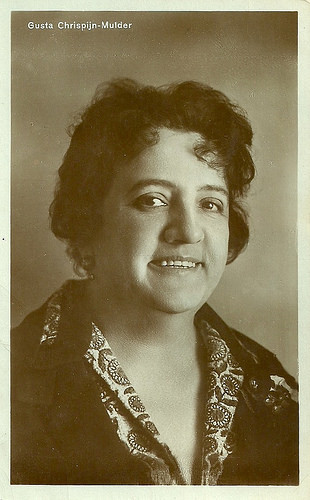
Dutch postcard by Ed. Weenenk & Snel, The Hague.
Frou-frou
Gusta Chrispijn-Mulder was born Augusta Geertruida Maria Mulder in Amsterdam in 1876. Her parents were Herman Mulder and Augusta Maria Hilverdink.
As ‘Guusje Mulder’ she debuted in 1893 at the Amsterdam Salon des Variétés under direction of M. Kreukniet and H. Poolman. She then acted with the Van Lier Brothers in plays such as Victorien Sardou’s Frou-frou.
Subsequently she was engaged for 10 years by the Nederlandsch Toneel. In 1911 she went to the Toneelvereniging and performed in the major Dutch plays Vorstenschool (Kings School) by Multatuli and Allerzielen (All Souls) by Herman Heijermans.
Chrispijn-Mulder also worked at the Rotterdams Toneel. In 1917 she moved to the Hofstad Toneel in The Hague, in 1924 at the Odeon-Theatre in the same city.

Louis Chrispijn junior . Dutch postcard by Weenenk & Snel, Den Haag. Photo: Willem Coret.
Famous for her clear declamation
In 1902 Gusta Chrispijn was married to actor-director Louis Chrispijn junior (1876-1931) and was the mother of actress Lous (Louise) Chrispijn (1898-1940). Apparently their daughter was born before they were married.
While her husband had been active as director and actor in silent cinema in the 1910s, Gusta didn’t act in silent films. When sound cinema set in in the Netherlands, though, Gusta Chrispijn-Mulder, who was famous for her clear declamation, often played supporting parts.
She was often casted as negative characters, such as the acrimonious Arabella who is taught a lesson in the Dutch comedy De familie van mijn vrouw/My Wife's Family (Jaap Speyer, 1935), starring Sylvain Poons as Arabella’s husband Josef.
Other parts followed in the comedies Het meisje met den blauwen hoed/The Girl with the Blue Hat (Rudolf Meinert 1934), starring Truus van Aalten and Roland Varno , Malle gevallen/Silly Situations (Jaap Speyer, 1934), starring Louis Borel , Roland Varno and Jopie Koopman , De vier Mullers/The four Mullers (Rudolf Meinert, 1934), starring Johan Heesters , and Amsterdam bij nacht/Amsterdam by Night (Alex Benno, 1936), starring Louis de Bree and Annie van Duyn .
In 1937-1938 she did a 10-months stage tour with the company of Cor Ruys through the former Dutch East Indies (now Indonesia).
Her last film part was as director of the orphanage in Vadertje Langbeen/Daddy Longlegs (Friedrich Zelnik, 1938), based on Jean Webster’s novella Daddy-Long-Legs and its subsequent play, and starring Lily Bouwmeester as the girl who falls in love with her benefactor (Paul Storm).
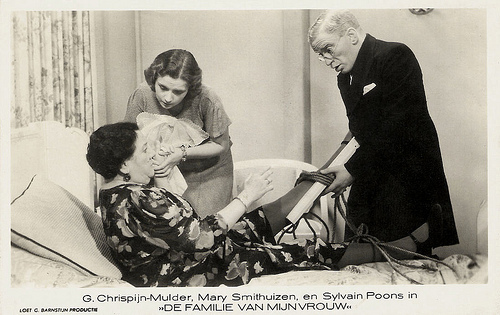
Dutch postcard by M. B.& Z. (M. Bonnist & Zonen, Amsterdam). Photo: Loet C. Barnstijn Film. Publicity still for De familie van mijn vrouw/My Wife's Family (Jaap Speyer, 1935) with Mary Smithuysen and Sylvain Poons .
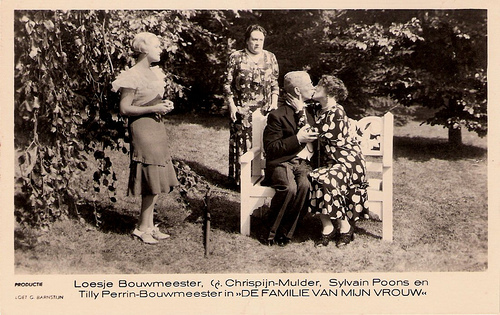
Dutch postcard by M. B.& Z. (M. Bonnist & Zonen, Amsterdam). Photo: Loet C. Barnstijn Film. Publicity still for De familie van mijn vrouw/My Wife's Family (Jaap Speyer, 1935) with Loesje Bouwmeester , Sylvain Poons and Tilly Perin-Bouwmeester.
Expelled from the stage for five years
During the Second World War Gusta Chrispijn-Mulder, who had already lost her husband in 1931 also lost her daughter, who died at the age of 42 in July 1940.
During the war Gusta didn’t act in films, though some of her 1930s films were still shown in cinemas. There had been a plan in late 1940 to act in short films by director Gerard Rutten, but this project never materialised.
In addition to some radio work and declamation lessons, she mainly acted on stage at the theatre companies De Voortrekkers, Noordhollands Toneel and De Komedianten. At the Noordhollands Toneel she was one of the best paid actresses, earning 5000 guilders per year, and in plays directed by Jan de Vos she had leads, though being in her sixties already.
Because of this she was sentenced in 1945 to be expelled from the stage for five years, but in 1947 this was withdrawn.
Gusta Chrispijn-Mulder died at age 78 in Amsterdam in 1955. She was buried on the Amsterdam cemetery Zorgvlied.
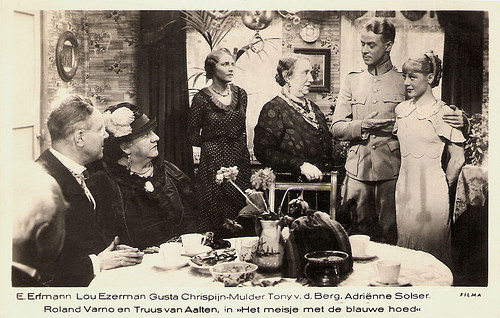
Dutch postcard by M. B. & Z. (M. Bonnist & Zonen, Amsterdam). Photo: Filma. Publicity still for Het Meisje met de Blauwe Hoed/The Girl with the Blue Hat (Rudolf Meinert, 1934) with a.o. Roland Varno and Truus van Aalten .
Clip from De familie van mijn vrouw/My Wife's Family (Jaap Speyer, 1935). Source: Eye (YouTube).
Clip from Amsterdam bij nacht/Amsterdam by Night (Alex Benno, 1936). Source: Eye (YouTube).
Sources: Eyefilm, Delpher and .

Dutch postcard by Ed. Weenenk & Snel, The Hague.
Frou-frou
Gusta Chrispijn-Mulder was born Augusta Geertruida Maria Mulder in Amsterdam in 1876. Her parents were Herman Mulder and Augusta Maria Hilverdink.
As ‘Guusje Mulder’ she debuted in 1893 at the Amsterdam Salon des Variétés under direction of M. Kreukniet and H. Poolman. She then acted with the Van Lier Brothers in plays such as Victorien Sardou’s Frou-frou.
Subsequently she was engaged for 10 years by the Nederlandsch Toneel. In 1911 she went to the Toneelvereniging and performed in the major Dutch plays Vorstenschool (Kings School) by Multatuli and Allerzielen (All Souls) by Herman Heijermans.
Chrispijn-Mulder also worked at the Rotterdams Toneel. In 1917 she moved to the Hofstad Toneel in The Hague, in 1924 at the Odeon-Theatre in the same city.

Louis Chrispijn junior . Dutch postcard by Weenenk & Snel, Den Haag. Photo: Willem Coret.
Famous for her clear declamation
In 1902 Gusta Chrispijn was married to actor-director Louis Chrispijn junior (1876-1931) and was the mother of actress Lous (Louise) Chrispijn (1898-1940). Apparently their daughter was born before they were married.
While her husband had been active as director and actor in silent cinema in the 1910s, Gusta didn’t act in silent films. When sound cinema set in in the Netherlands, though, Gusta Chrispijn-Mulder, who was famous for her clear declamation, often played supporting parts.
She was often casted as negative characters, such as the acrimonious Arabella who is taught a lesson in the Dutch comedy De familie van mijn vrouw/My Wife's Family (Jaap Speyer, 1935), starring Sylvain Poons as Arabella’s husband Josef.
Other parts followed in the comedies Het meisje met den blauwen hoed/The Girl with the Blue Hat (Rudolf Meinert 1934), starring Truus van Aalten and Roland Varno , Malle gevallen/Silly Situations (Jaap Speyer, 1934), starring Louis Borel , Roland Varno and Jopie Koopman , De vier Mullers/The four Mullers (Rudolf Meinert, 1934), starring Johan Heesters , and Amsterdam bij nacht/Amsterdam by Night (Alex Benno, 1936), starring Louis de Bree and Annie van Duyn .
In 1937-1938 she did a 10-months stage tour with the company of Cor Ruys through the former Dutch East Indies (now Indonesia).
Her last film part was as director of the orphanage in Vadertje Langbeen/Daddy Longlegs (Friedrich Zelnik, 1938), based on Jean Webster’s novella Daddy-Long-Legs and its subsequent play, and starring Lily Bouwmeester as the girl who falls in love with her benefactor (Paul Storm).

Dutch postcard by M. B.& Z. (M. Bonnist & Zonen, Amsterdam). Photo: Loet C. Barnstijn Film. Publicity still for De familie van mijn vrouw/My Wife's Family (Jaap Speyer, 1935) with Mary Smithuysen and Sylvain Poons .

Dutch postcard by M. B.& Z. (M. Bonnist & Zonen, Amsterdam). Photo: Loet C. Barnstijn Film. Publicity still for De familie van mijn vrouw/My Wife's Family (Jaap Speyer, 1935) with Loesje Bouwmeester , Sylvain Poons and Tilly Perin-Bouwmeester.
Expelled from the stage for five years
During the Second World War Gusta Chrispijn-Mulder, who had already lost her husband in 1931 also lost her daughter, who died at the age of 42 in July 1940.
During the war Gusta didn’t act in films, though some of her 1930s films were still shown in cinemas. There had been a plan in late 1940 to act in short films by director Gerard Rutten, but this project never materialised.
In addition to some radio work and declamation lessons, she mainly acted on stage at the theatre companies De Voortrekkers, Noordhollands Toneel and De Komedianten. At the Noordhollands Toneel she was one of the best paid actresses, earning 5000 guilders per year, and in plays directed by Jan de Vos she had leads, though being in her sixties already.
Because of this she was sentenced in 1945 to be expelled from the stage for five years, but in 1947 this was withdrawn.
Gusta Chrispijn-Mulder died at age 78 in Amsterdam in 1955. She was buried on the Amsterdam cemetery Zorgvlied.

Dutch postcard by M. B. & Z. (M. Bonnist & Zonen, Amsterdam). Photo: Filma. Publicity still for Het Meisje met de Blauwe Hoed/The Girl with the Blue Hat (Rudolf Meinert, 1934) with a.o. Roland Varno and Truus van Aalten .
Clip from De familie van mijn vrouw/My Wife's Family (Jaap Speyer, 1935). Source: Eye (YouTube).
Clip from Amsterdam bij nacht/Amsterdam by Night (Alex Benno, 1936). Source: Eye (YouTube).
Sources: Eyefilm, Delpher and .
Published on June 22, 2015 22:00
June 21, 2015
Elfriede Heisler
German actress Elfriede Heisler (1885-1919) was a star of the early silent film era. She appeared in 11 German and Austrian films and her career was promising, but at 33, she committed suicide.
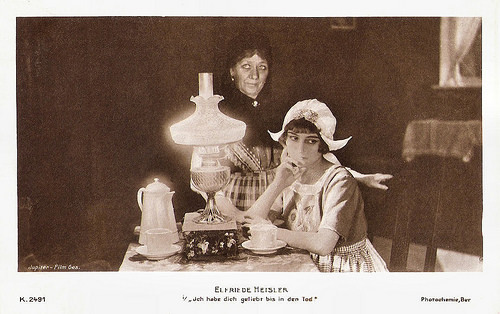
German postcard by Photochemie, Berlin, no. K.2491. Photo: Jupiter-Film Ges. Photo: publicity still for Ich habe dich geliebt bis in den Tod//I have loved you to death (1918).
The wandering Jew
Elfriede Heisler was born Elfriede Quabius in 1885 in Breslau, Germany (according to some sources, she was born in 1889).
She started her acting career in the theatre. Heisler worked in the provinces and later at the Friedrich-Wilhelmstädtischen Schauspielhaus in Berlin. In 1910 she got an engagement at the Königliche Berliner Schauspielhaus, where she played leading roles in light entertainment plays.
In 1912, she made her camera debut and played under the direction of Emil Albes in short silent films like Der Dritte/The Third (Emil Albes, 1912) with Hans Mierendorf , and Fürstenliebe/Royal Love (Emil Albes, 1912) starring Hugo Flink.
IMDb only mentions three of her later films: the patriotic drama Schwert und Herd/Sword and Hearth (Georg Victor Mendel, 1916) starring Carl de Vogt , Die lachende Maske/The Laughing Mask (Willy Zeyn, 1918) with Rosa Valetti, and the biblical epic Das Buch Esther/The Book of Esther (Uwe Jens Krafft, Ernst Reicher, 1919). Co-director Ernst Reicher played Ahasver or the wandering Jew, and Stella Harf played Queen Esther.
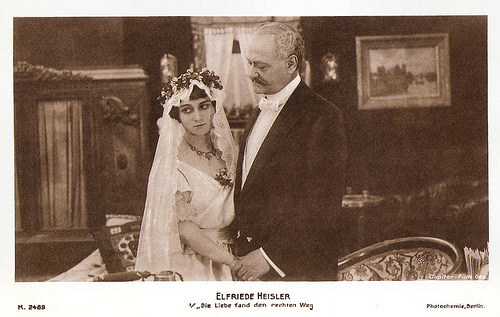
German postcard by Photochemie, Berlin, no. K.2489. Photo: Jupiter-Film Ges. Photo: publicity still for Die Liebe fand den rechten Weg/Love was on the right path (N.N., 1918).
Suicide
At Steffi-Line , Stephanie D’heil mentions also the film Seltsame Seelen/Strange Souls (Emil Albes, Margot Meyer, 1918), and Thomas Staedeli at Cyranos adds Die Tarantella/The Tarantella (N.N., 1912) with Hugo Flink and Ludwig Trautmann , and Frauchen in Nöten/Owner in trouble (William Karfiol, 1918) with Kurt Vespermann .
In Austria she played for Jupiter Film in Ich habe Dich geliebt bis in den Tod/I have loved you to death (1918), Das Glück im Rinnstein/The happiness in the gutter (1918), and Die Liebe fand den rechten Weg/Love was on the right path (1918), with Erwin Fichtner.
When her final film, Das Buch Esther/The Book of Esther, was first shown in the cinemas in 1919, the star of the film was no longer alive.
Elfriede Heisler had died in 1919 in the aftermath of a suicide attempt with Veronal (barbital). Reportedly, the motive for the suicide attempt was an unhappy love affair. She was only 33.
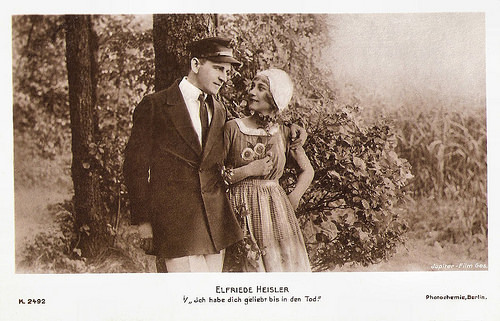
German postcard by Photochemie, Berlin, no. K.2492. Photo: Jupiter-Film Ges. Photo: publicity still for Ich habe dich geliebt bis in den Tod/I have loved you to death (N.N., 1918). Her co-star in this film was Erwin Fichtner.
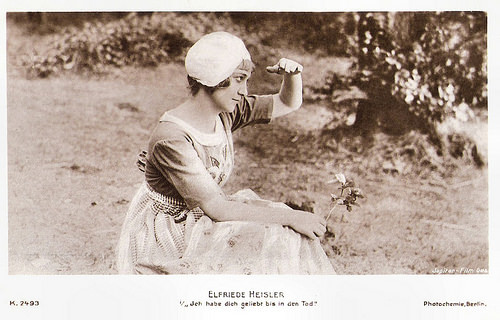
German postcard by Photochemie, Berlin, no. K.2493. Photo: Jupiter-Film Ges. Photo: publicity still for Ich habe dich geliebt bis in den Tod//I have loved you to death (N.N., 1918).
Sources: Stephanie D’heil (Steffi-Line - German), Thomas Staedeli (Cyranos), The German Early Cinema Database, Wikipedia (German) and .

German postcard by Photochemie, Berlin, no. K.2491. Photo: Jupiter-Film Ges. Photo: publicity still for Ich habe dich geliebt bis in den Tod//I have loved you to death (1918).
The wandering Jew
Elfriede Heisler was born Elfriede Quabius in 1885 in Breslau, Germany (according to some sources, she was born in 1889).
She started her acting career in the theatre. Heisler worked in the provinces and later at the Friedrich-Wilhelmstädtischen Schauspielhaus in Berlin. In 1910 she got an engagement at the Königliche Berliner Schauspielhaus, where she played leading roles in light entertainment plays.
In 1912, she made her camera debut and played under the direction of Emil Albes in short silent films like Der Dritte/The Third (Emil Albes, 1912) with Hans Mierendorf , and Fürstenliebe/Royal Love (Emil Albes, 1912) starring Hugo Flink.
IMDb only mentions three of her later films: the patriotic drama Schwert und Herd/Sword and Hearth (Georg Victor Mendel, 1916) starring Carl de Vogt , Die lachende Maske/The Laughing Mask (Willy Zeyn, 1918) with Rosa Valetti, and the biblical epic Das Buch Esther/The Book of Esther (Uwe Jens Krafft, Ernst Reicher, 1919). Co-director Ernst Reicher played Ahasver or the wandering Jew, and Stella Harf played Queen Esther.

German postcard by Photochemie, Berlin, no. K.2489. Photo: Jupiter-Film Ges. Photo: publicity still for Die Liebe fand den rechten Weg/Love was on the right path (N.N., 1918).
Suicide
At Steffi-Line , Stephanie D’heil mentions also the film Seltsame Seelen/Strange Souls (Emil Albes, Margot Meyer, 1918), and Thomas Staedeli at Cyranos adds Die Tarantella/The Tarantella (N.N., 1912) with Hugo Flink and Ludwig Trautmann , and Frauchen in Nöten/Owner in trouble (William Karfiol, 1918) with Kurt Vespermann .
In Austria she played for Jupiter Film in Ich habe Dich geliebt bis in den Tod/I have loved you to death (1918), Das Glück im Rinnstein/The happiness in the gutter (1918), and Die Liebe fand den rechten Weg/Love was on the right path (1918), with Erwin Fichtner.
When her final film, Das Buch Esther/The Book of Esther, was first shown in the cinemas in 1919, the star of the film was no longer alive.
Elfriede Heisler had died in 1919 in the aftermath of a suicide attempt with Veronal (barbital). Reportedly, the motive for the suicide attempt was an unhappy love affair. She was only 33.

German postcard by Photochemie, Berlin, no. K.2492. Photo: Jupiter-Film Ges. Photo: publicity still for Ich habe dich geliebt bis in den Tod/I have loved you to death (N.N., 1918). Her co-star in this film was Erwin Fichtner.

German postcard by Photochemie, Berlin, no. K.2493. Photo: Jupiter-Film Ges. Photo: publicity still for Ich habe dich geliebt bis in den Tod//I have loved you to death (N.N., 1918).
Sources: Stephanie D’heil (Steffi-Line - German), Thomas Staedeli (Cyranos), The German Early Cinema Database, Wikipedia (German) and .
Published on June 21, 2015 22:00
June 20, 2015
Joan Greenwood
Silky, English actress Joan Greenwood (1921-1987) made several memorable appearances in classic film comedies of the 1940s and 1950s. Her husky, sultry voice was her trademark, and in 1995 she was ranked number 63 on Empire magazine's list of the 100 Sexiest Stars in film history.
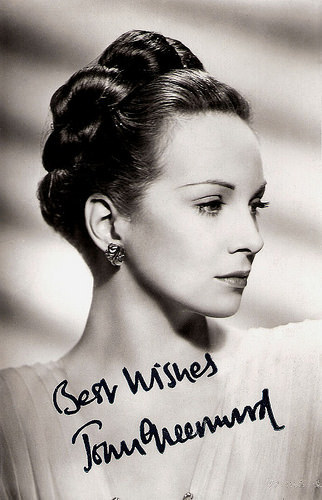
British postcard by Astra. Photo: J. Arthur Rank Organisation.
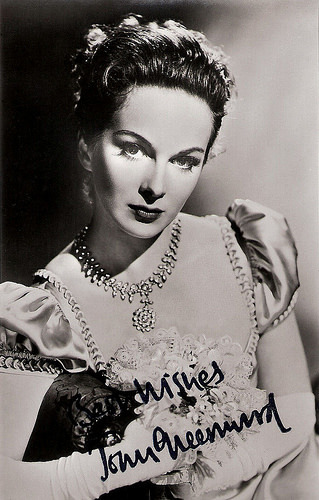
British autograph card.
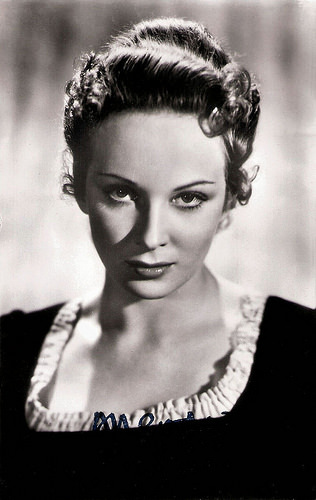
British autograph card.
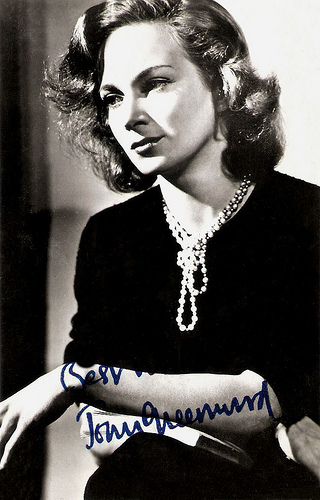
British postcard.
A Special Blend of the Aristocratic and the Sultry
Joan Greenwood was born in Chelsea in 1921 as the daughter of renowned British artist Sydney Earnshaw Greenwood.
She was trained at the Royal Academy of Dramatic Art and made her stage debut at age 18. Three years later she was cast by Leslie Howard opposite himself in the wartime morale-booster The Gentle Sex (Leslie Howard, 1942). On the stage she appeared with Donald Wolfit's theatre company in the years following World War II.
The gifted Greenwood possessed a special blend of the aristocratic and the sultry which made her extremely useful for a time in British film. Between 1948 and 1958 she made several memorable screen appearances, most notably as Sibella, the bewitching, blackmailing mistress of anti-hero Dennis Price in the black comedy Kind Hearts and Coronets (Robert Hamer, 1949), and as the Honourable Gwendolen Fairfax in the film adaptation of Oscar Wilde’s The Importance of Being Earnest (Anthony Asquith, 1952).
She also appeared in two Ealing comedies, Whisky Galore! (Alexander Mackendrick, 1949) and as the mercenary lady friend of inventor Alec Guinness in The Man in the White Suit (Alexander Mackendrick, 1952).
In 1954, she starred in her first Broadway production, The Confidential Clerk. Other films in which she appeared include Monsieur Ripois (René Clément, 1954) starring Gérard Philipe , Father Brown (Robert Hamer, 1954) opposite Alec Guinness , the Gothic Swashbuckler Moonfleet (Fritz Lang, 1955) with Stewart Granger , and Stage Struck (Sidney Lumet, 1958) starring Henry Fonda.
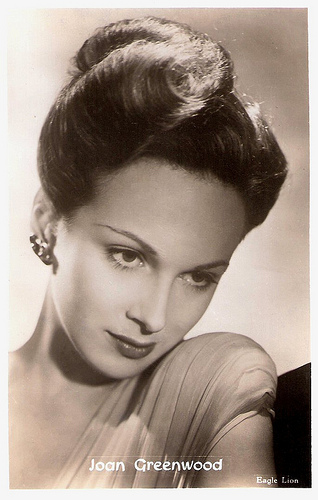
Vintage postcard. Photo: Eagle Lion.
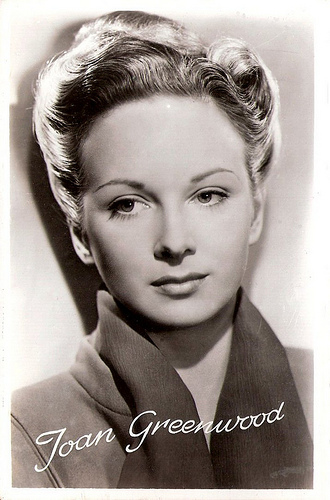
Dutch postcard by Uitg. Takken, Utrecht.

German postcard by Film-Postkartenverlag Hbg., Bergedorf, no. 159. Photo: J. Arthur Rank Organisation.
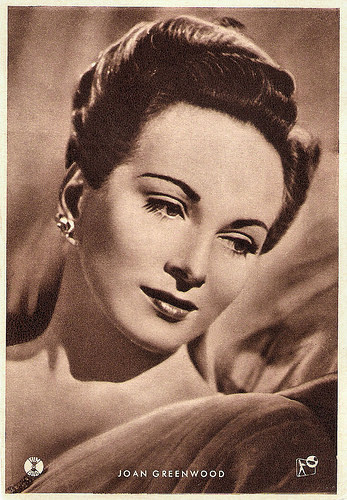
German collectors card, no. 4408. Photo: Fox Film.
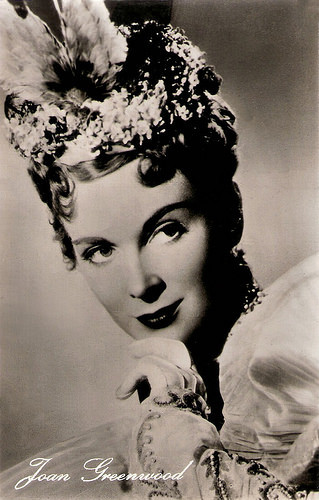
East-German postcard by VEB Progress Film-Vertrieb, Berlin, no. 1068, 1959. Photo: J. Arthur Rank. Publicity still for The Importance of Being Earnest (Anthony Asquith, 1952).
More Eccentric Than Sexy
From the 1960s on Joan Greenwood specialized in highly enjoyable character roles, still classy and authoritative but more eccentric than sexy. Her films included the Jules Verne based Mysterious Island (Cy Endfield, 1961), and Tom Jones (Tony Richardson, 1963), for which she was nominated for a Golden Globe as Best Supporting Actress.
In 1960, Greenwood appeared as the title character in a stage production of Henrik Ibsen's Hedda Gabler at The Oxford Playhouse. Starring opposite her as Brack was the actor André Morell. They fell in love and flew in secret to Jamaica, where they were married, remaining together until his death in 1978.
On TV she appeared as Lady Carlton, a quirky romance novelist and landlady to the main characters in the British sitcom Girls On Top (1985) with Dawn French and Jennifer Saunders.
In 1987 Joan Greenwood died of a heart attack in London five days prior to her 66th birthday. Her last film was the fine Charles Dickens adaptation Little Dorrit (Christine Edzard, 1988), made the year of her death. She and André Morell had one child, actor Jason Morell.
Trailer Kind Hearts and Coronets (1949). Source: Hermthy (YouTube).
Trailer The Importance of Being Earnest (1952). Source: MOVIECLIPS Classic Trailers (YouTube).
Trailer of Mysterious Island (1961). Source: Plamen Plamenov (YouTube).
Trailer of Tom Jones (1963). Source: R6dw6C (YouTube).
Sources: Hal Erickson (AllMovie), Wikipedia, TCM Movie Database, and .

British postcard by Astra. Photo: J. Arthur Rank Organisation.

British autograph card.

British autograph card.

British postcard.
A Special Blend of the Aristocratic and the Sultry
Joan Greenwood was born in Chelsea in 1921 as the daughter of renowned British artist Sydney Earnshaw Greenwood.
She was trained at the Royal Academy of Dramatic Art and made her stage debut at age 18. Three years later she was cast by Leslie Howard opposite himself in the wartime morale-booster The Gentle Sex (Leslie Howard, 1942). On the stage she appeared with Donald Wolfit's theatre company in the years following World War II.
The gifted Greenwood possessed a special blend of the aristocratic and the sultry which made her extremely useful for a time in British film. Between 1948 and 1958 she made several memorable screen appearances, most notably as Sibella, the bewitching, blackmailing mistress of anti-hero Dennis Price in the black comedy Kind Hearts and Coronets (Robert Hamer, 1949), and as the Honourable Gwendolen Fairfax in the film adaptation of Oscar Wilde’s The Importance of Being Earnest (Anthony Asquith, 1952).
She also appeared in two Ealing comedies, Whisky Galore! (Alexander Mackendrick, 1949) and as the mercenary lady friend of inventor Alec Guinness in The Man in the White Suit (Alexander Mackendrick, 1952).
In 1954, she starred in her first Broadway production, The Confidential Clerk. Other films in which she appeared include Monsieur Ripois (René Clément, 1954) starring Gérard Philipe , Father Brown (Robert Hamer, 1954) opposite Alec Guinness , the Gothic Swashbuckler Moonfleet (Fritz Lang, 1955) with Stewart Granger , and Stage Struck (Sidney Lumet, 1958) starring Henry Fonda.

Vintage postcard. Photo: Eagle Lion.

Dutch postcard by Uitg. Takken, Utrecht.

German postcard by Film-Postkartenverlag Hbg., Bergedorf, no. 159. Photo: J. Arthur Rank Organisation.

German collectors card, no. 4408. Photo: Fox Film.

East-German postcard by VEB Progress Film-Vertrieb, Berlin, no. 1068, 1959. Photo: J. Arthur Rank. Publicity still for The Importance of Being Earnest (Anthony Asquith, 1952).
More Eccentric Than Sexy
From the 1960s on Joan Greenwood specialized in highly enjoyable character roles, still classy and authoritative but more eccentric than sexy. Her films included the Jules Verne based Mysterious Island (Cy Endfield, 1961), and Tom Jones (Tony Richardson, 1963), for which she was nominated for a Golden Globe as Best Supporting Actress.
In 1960, Greenwood appeared as the title character in a stage production of Henrik Ibsen's Hedda Gabler at The Oxford Playhouse. Starring opposite her as Brack was the actor André Morell. They fell in love and flew in secret to Jamaica, where they were married, remaining together until his death in 1978.
On TV she appeared as Lady Carlton, a quirky romance novelist and landlady to the main characters in the British sitcom Girls On Top (1985) with Dawn French and Jennifer Saunders.
In 1987 Joan Greenwood died of a heart attack in London five days prior to her 66th birthday. Her last film was the fine Charles Dickens adaptation Little Dorrit (Christine Edzard, 1988), made the year of her death. She and André Morell had one child, actor Jason Morell.
Trailer Kind Hearts and Coronets (1949). Source: Hermthy (YouTube).
Trailer The Importance of Being Earnest (1952). Source: MOVIECLIPS Classic Trailers (YouTube).
Trailer of Mysterious Island (1961). Source: Plamen Plamenov (YouTube).
Trailer of Tom Jones (1963). Source: R6dw6C (YouTube).
Sources: Hal Erickson (AllMovie), Wikipedia, TCM Movie Database, and .
Published on June 20, 2015 22:00
June 19, 2015
Il ponte dei sospiri (1921)
A pre-announcement. From 3 till 10 October, the 34th edition of the silent film festival Le Giornate del Cinema Muto will take place in Pordenone, Italy. We will be there. One of the sections is about the forzuti, the strong men of the silent Italian cinema, like Luciano Albertini. Although this section will focus on the films Albertini made in Germany, today EFSP has a film special about one of Albertini's earlier Italian films, the four part serial Il ponte dei sospiri/The Bridge of Sighs (Domenico Gaido, 1921), produced by his own production company, Albertini Film.
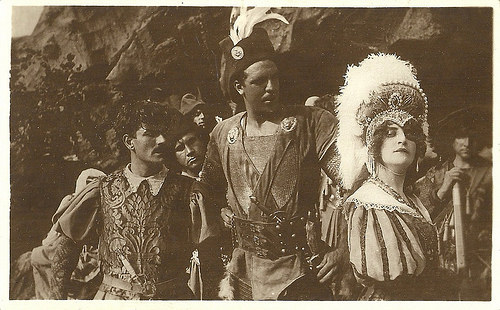
Italian postcard. Photo: Unione Cinematografica Italiana. Photo: Unione Cinematografica Italiana. Publicity still for Il ponte dei sospiri/The Bridge of Sighs (Domenico Gaido, 1921). Caption: Imperia,the most beautiful Roman courtesan, will select the bandit Scalabrino for one night of love, causing the hate and jealousy of Sandrigo.
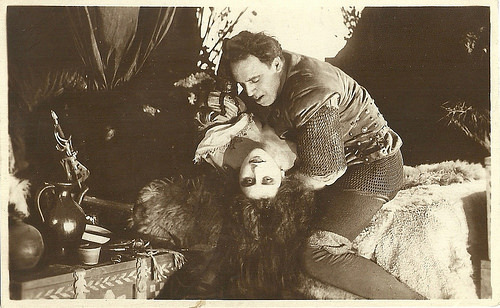
Italian postcard. Photo: Unione Cinematografica Italiana. Photo: Unione Cinematografica Italiana. Publicity still for Il ponte dei sospiri/The Bridge of Sighs (Domenico Gaido, 1921). Caption: In the cave of the bandits Imperia becomes the lover of Scalabrino.
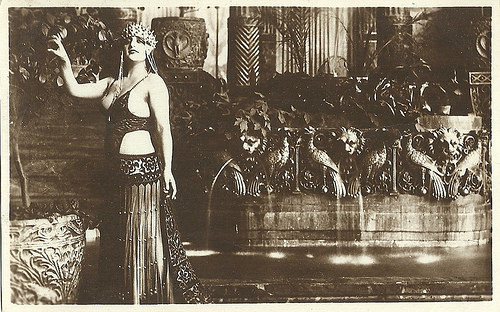
Italian postcard. Photo: Unione Cinematografica Italiana. Photo: Unione Cinematografica Italiana. Publicity still for Il ponte dei sospiri/The Bridge of Sighs (Domenico Gaido, 1921). Caption: Imperia, the empress of the courtesans, is dressed in ball attire, for her famous dances.
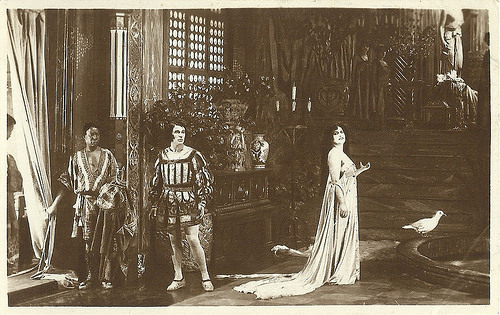
Italian postcard. Photo: Unione Cinematografica Italiana. Photo: Unione Cinematografica Italiana. Publicity still for Il ponte dei sospiri/The Bridge of Sighs (Domenico Gaido, 1921). Caption: Imperia tries to seduce Rolando, but she is rejected, and will vilely take revenge.
Falsely accused
The plot of Il ponte dei sospiri/The Bridge of Sighs (Domenico Gaido, 1921) reminds of Alexandre Dumas' novel The Count of Monte Christo.
Luciano Albertini plays Rolando Candiano, son of the Doge of Venice. Rolando is falsely accused of murder by his enemies.
One enemy, the Inquisitor Foscari (Armand Pouget) plots to become Doge himself, another (Altieri - Luigi Stinchi ) wants to steal the daughter of Dandolo (Bonaventura Ibanez), the beautiful Leonora (Carolina White), Rolando's fiancee, a third (Imperia - Antonietta Calderari) is a courtesan rejected by Rolando, and the fourth is Bembo (Agostino Borgato).
Imperia has killed a suitor, the men use her rejection by Rolando to push her to revenge herself and accuse Rolando. On the day of his marriage Rolando is arrested, trialled and passes the Bridge of Sighs before entering lifetime imprisonment.
His father is dethroned as Doge, blinded and reduced to a wandering beggar. His mother is mocked by the mob but saved by the courageous and good-hearted bandit Scalabrino (Onorato Garaveo), with whom Imperia had one night of love, resulting in her daughter Bianca.
There is also Sandrigo who hates Scalabrino who humiliated him in the past. Years after, Rolando manages to escape with the help of Scalabrino and take revenge.
The false Doge Foscari is dethroned but escapes the same fate of Doge Candiano, being blinded, as Candiano prevents the horrific act to happen twice. Foscari goes mad instead.
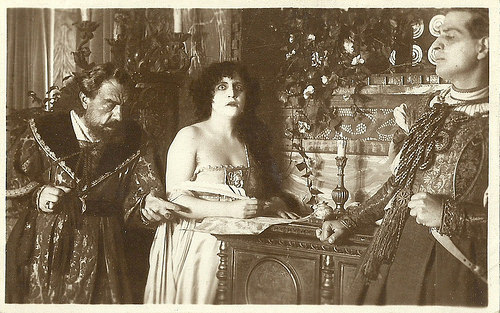
Italian postcard. Photo: Unione Cinematografica Italiana. Photo: Unione Cinematografica Italiana. Publicity still for Il ponte dei sospiri/The Bridge of Sighs (Domenico Gaido, 1921). Caption: The wrath of the torturer will fall upon the generous Rolando, who is innocently accused of having killed Giovanni Davila, who actually has been struck by Imperia's dagger (Imperia while signing the accusation).
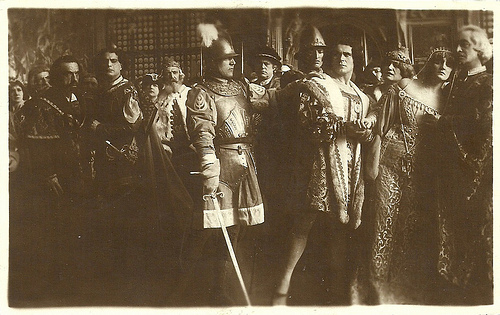
Italian postcard. Photo: Unione Cinematografica Italiana. Publicity still of Luciano Albertini as Rolando Candiano in Il ponte dei sospiri/The Bridge of Sighs (Domenico Gaido, 1921). From left to right Agostino Borgato (Bembo), Luigi Stinchi (Altieri), sig. Pieri (the Doge Candiano), an unknown actor as a soldier, Armand Pouget (the Inquisitor Foscari), Luciano Albertini (Rolando Candiano), Carolina White (Leonora) and Bonaventura Ibanez (her father Dandolo). Caption: On the auspicious eve of the wedding Rolando is arrested, and not the white bridal room and the kiss of his most beautiful bride await him but the Bridge of Sighs.
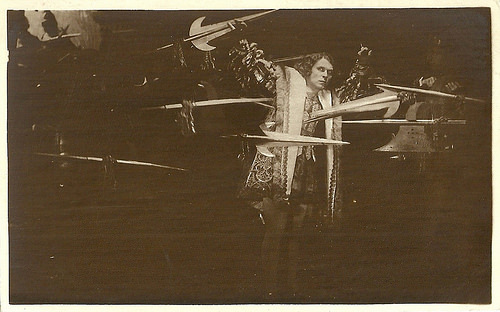
Italian postcard. Photo: Unione Cinematografica Italiana. Photo: Unione Cinematografica Italiana. Publicity still for Il ponte dei sospiri/The Bridge of Sighs (Domenico Gaido, 1921). Caption: The young and very brave son of Doge Candiano, Rolando ( Luciano Albertini ), is pushed into prison by halberds.
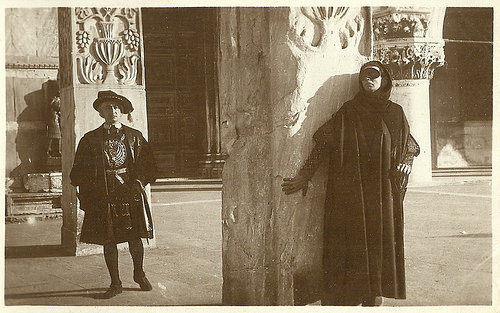
Italian postcard. Photo: Unione Cinematografica Italiana. Photo: Unione Cinematografica Italiana. Publicity still for Il ponte dei sospiri/The Bridge of Sighs (Domenico Gaido, 1921). Caption: Misfortune is lurking for Dandolo (Bonaventura Ibanez) (Altieri follows Dandolo to challenge him to death).
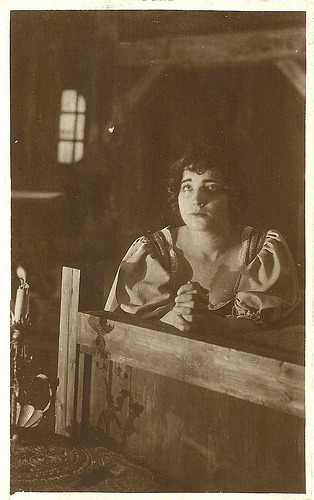
Italian postcard. Photo: Unione Cinematografica Italiana. Publicity still for Il ponte dei sospiri/The Bridge of Sighs (Domenico Gaido, 1921). Caption: Inana, prays for the soul of the unfortunate Dogaressa, Rolando's mother - saved from the mad ire of the populace by the bandit Scalabrino.
Acrobatic and daredevil acting
Muscular Italian actor Luciano Albertini (1882-1945) is best remembered for his acrobatic and daredevil acting in Italian and German silent cinema.
The serial Il ponte dei sospiri/The Bridge of Sighs (Domenico Gaido, 1921) was his last and most prestigious film in Italy, before pursing a very successful career in Germany with his own company Albertini Film, with Phoebus and finally with Aafa Film.
In 2002 the Roman Cineteca Nazionale restored the film in colour, in collaboration with Cineteca Italiana of Milan, Museo Nazionale del Cinema of Turin and Cinémathéque Suisse of Lausanne.
The restored film was presented at the 2004 Giornate del Cinema Muto. Film scholar Vittorio Martinelli considered it his best film.
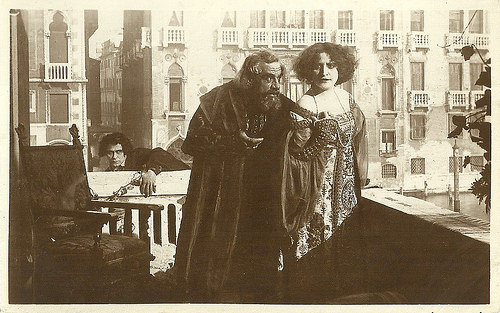
Italian postcard. Photo: Unione Cinematografica Italiana. Photo: Unione Cinematografica Italiana. Publicity still for Il ponte dei sospiri/The Bridge of Sighs (Domenico Gaido, 1921). Caption: Bembo tries to cheat Imperia and take her daughter from her, in whom he is madly in love with, but Rolando ( Luciano Albertini ) watches over her and will prevent the deceit which might strike the very sweet Bianca.
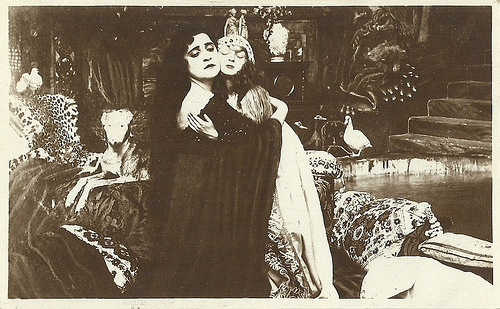
Italian postcard. Photo: Unione Cinematografica Italiana. Photo: Unione Cinematografica Italiana. Publicity still for Il ponte dei sospiri/The Bridge of Sighs (Domenico Gaido, 1921). Caption: Imperia's only true love: the little Bianca, daughter of Scalabrino.
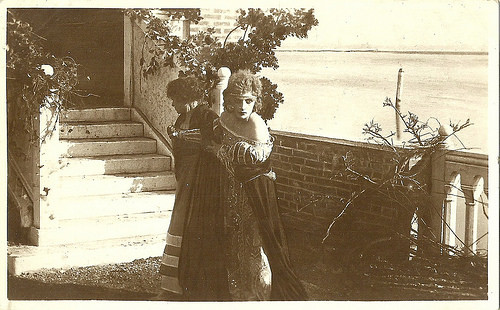
Italian postcard. Photo: Unione Cinematografica Italiana. Photo: Unione Cinematografica Italiana. Publicity still for Il ponte dei sospiri/The Bridge of Sighs (Domenico Gaido, 1921). Caption: Bianca flees from the party to escape her husband Sandrigo.
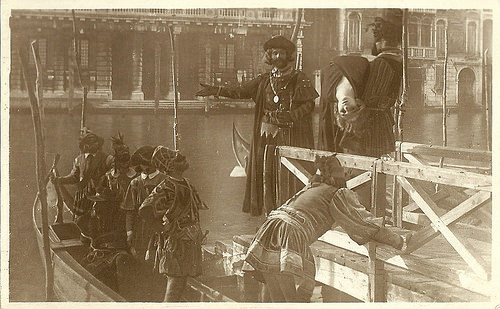
Italian postcard. Photo: Unione Cinematografica Italiana. Photo: Unione Cinematografica Italiana. Publicity still for Il ponte dei sospiri/The Bridge of Sighs (Domenico Gaido, 1921). Caption: In order to revenge himself, Rolando orders to steal her daughter Bianca.
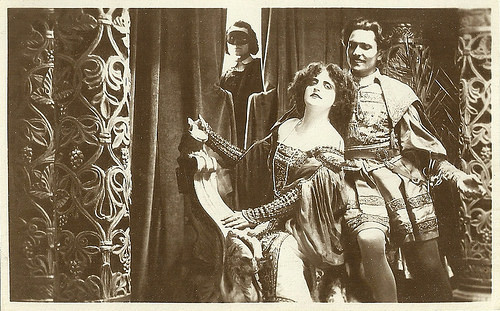
Italian postcard. Photo: Unione Cinematografica Italiana. Photo: Unione Cinematografica Italiana. Publicity still for Il ponte dei sospiri/The Bridge of Sighs (Domenico Gaido, 1921). Caption: Imperia smiles perfidiously with her mysterious, deep eyes, satisfied about her atrocious revenge, unsuspecting that her penalty is awaiting her.
Opera Singer
One of the leading ladies of Il ponte dei sospiri/The Bridge of Sighs (Domenico Gaido, 1921) is the American opera singer Carolina White.
White was born in 1885 in Grafton, Mass., and had a short-lived film career. She played opposite the famous opera singer Enrico Caruso in My Cousin (Edward José, 1918).
In 1921 she played the love interest of Luciano Albertini in Il ponte dei sospiri (Domenico Gaido, 1921) which was partly shot on location in Venice.
After that Carolina White didn't act in film anymore. She died in Rome in 1961.
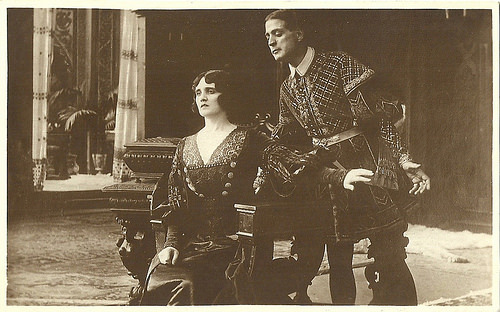
Italian postcard. Photo: Unione Cinematografica Italiana. Publicity still for Il ponte dei sospiri/The Bridge of Sighs (Domenico Gaido, 1921). Caption: Altieri longs for the moment in which he can finally kiss his wife on her lips. But Leonora heroically remains faithful to her old and unforgotten love. Only Rolando may enjoy the divine kiss from her lips.
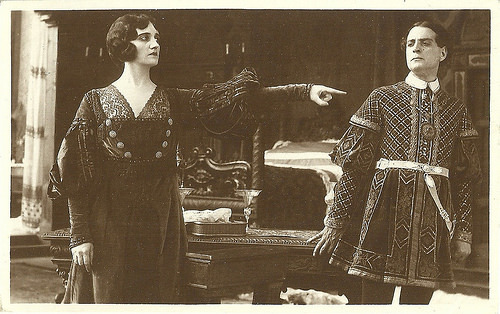
Italian postcard. Photo: Unione Cinematografica Italiana. Publicity still for Il ponte dei sospiri/The Bridge of Sighs (Domenico Gaido, 1921). Caption: Leonora chases her husband, about whom she has discovered the infamy and complicity with Imperia to Rolando's detriment.
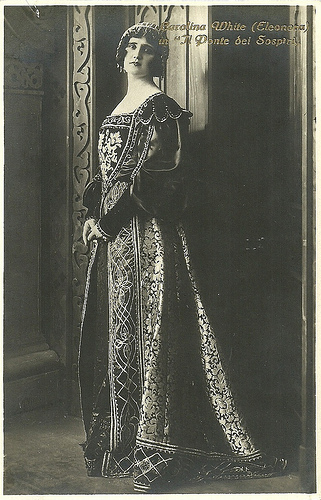
Italian postcard by Ed. G.B. Falci, Milano, no. 56. Photo: La Fotominio. Carolina White in Il ponte dei sospiri/The Bridge of Sighs (Domenico Gaido, 1921).
Sources: E Muto Fu (Italian), sempre in penombra (Italian) and IMDb.

Italian postcard. Photo: Unione Cinematografica Italiana. Photo: Unione Cinematografica Italiana. Publicity still for Il ponte dei sospiri/The Bridge of Sighs (Domenico Gaido, 1921). Caption: Imperia,the most beautiful Roman courtesan, will select the bandit Scalabrino for one night of love, causing the hate and jealousy of Sandrigo.

Italian postcard. Photo: Unione Cinematografica Italiana. Photo: Unione Cinematografica Italiana. Publicity still for Il ponte dei sospiri/The Bridge of Sighs (Domenico Gaido, 1921). Caption: In the cave of the bandits Imperia becomes the lover of Scalabrino.

Italian postcard. Photo: Unione Cinematografica Italiana. Photo: Unione Cinematografica Italiana. Publicity still for Il ponte dei sospiri/The Bridge of Sighs (Domenico Gaido, 1921). Caption: Imperia, the empress of the courtesans, is dressed in ball attire, for her famous dances.

Italian postcard. Photo: Unione Cinematografica Italiana. Photo: Unione Cinematografica Italiana. Publicity still for Il ponte dei sospiri/The Bridge of Sighs (Domenico Gaido, 1921). Caption: Imperia tries to seduce Rolando, but she is rejected, and will vilely take revenge.
Falsely accused
The plot of Il ponte dei sospiri/The Bridge of Sighs (Domenico Gaido, 1921) reminds of Alexandre Dumas' novel The Count of Monte Christo.
Luciano Albertini plays Rolando Candiano, son of the Doge of Venice. Rolando is falsely accused of murder by his enemies.
One enemy, the Inquisitor Foscari (Armand Pouget) plots to become Doge himself, another (Altieri - Luigi Stinchi ) wants to steal the daughter of Dandolo (Bonaventura Ibanez), the beautiful Leonora (Carolina White), Rolando's fiancee, a third (Imperia - Antonietta Calderari) is a courtesan rejected by Rolando, and the fourth is Bembo (Agostino Borgato).
Imperia has killed a suitor, the men use her rejection by Rolando to push her to revenge herself and accuse Rolando. On the day of his marriage Rolando is arrested, trialled and passes the Bridge of Sighs before entering lifetime imprisonment.
His father is dethroned as Doge, blinded and reduced to a wandering beggar. His mother is mocked by the mob but saved by the courageous and good-hearted bandit Scalabrino (Onorato Garaveo), with whom Imperia had one night of love, resulting in her daughter Bianca.
There is also Sandrigo who hates Scalabrino who humiliated him in the past. Years after, Rolando manages to escape with the help of Scalabrino and take revenge.
The false Doge Foscari is dethroned but escapes the same fate of Doge Candiano, being blinded, as Candiano prevents the horrific act to happen twice. Foscari goes mad instead.

Italian postcard. Photo: Unione Cinematografica Italiana. Photo: Unione Cinematografica Italiana. Publicity still for Il ponte dei sospiri/The Bridge of Sighs (Domenico Gaido, 1921). Caption: The wrath of the torturer will fall upon the generous Rolando, who is innocently accused of having killed Giovanni Davila, who actually has been struck by Imperia's dagger (Imperia while signing the accusation).

Italian postcard. Photo: Unione Cinematografica Italiana. Publicity still of Luciano Albertini as Rolando Candiano in Il ponte dei sospiri/The Bridge of Sighs (Domenico Gaido, 1921). From left to right Agostino Borgato (Bembo), Luigi Stinchi (Altieri), sig. Pieri (the Doge Candiano), an unknown actor as a soldier, Armand Pouget (the Inquisitor Foscari), Luciano Albertini (Rolando Candiano), Carolina White (Leonora) and Bonaventura Ibanez (her father Dandolo). Caption: On the auspicious eve of the wedding Rolando is arrested, and not the white bridal room and the kiss of his most beautiful bride await him but the Bridge of Sighs.

Italian postcard. Photo: Unione Cinematografica Italiana. Photo: Unione Cinematografica Italiana. Publicity still for Il ponte dei sospiri/The Bridge of Sighs (Domenico Gaido, 1921). Caption: The young and very brave son of Doge Candiano, Rolando ( Luciano Albertini ), is pushed into prison by halberds.

Italian postcard. Photo: Unione Cinematografica Italiana. Photo: Unione Cinematografica Italiana. Publicity still for Il ponte dei sospiri/The Bridge of Sighs (Domenico Gaido, 1921). Caption: Misfortune is lurking for Dandolo (Bonaventura Ibanez) (Altieri follows Dandolo to challenge him to death).

Italian postcard. Photo: Unione Cinematografica Italiana. Publicity still for Il ponte dei sospiri/The Bridge of Sighs (Domenico Gaido, 1921). Caption: Inana, prays for the soul of the unfortunate Dogaressa, Rolando's mother - saved from the mad ire of the populace by the bandit Scalabrino.
Acrobatic and daredevil acting
Muscular Italian actor Luciano Albertini (1882-1945) is best remembered for his acrobatic and daredevil acting in Italian and German silent cinema.
The serial Il ponte dei sospiri/The Bridge of Sighs (Domenico Gaido, 1921) was his last and most prestigious film in Italy, before pursing a very successful career in Germany with his own company Albertini Film, with Phoebus and finally with Aafa Film.
In 2002 the Roman Cineteca Nazionale restored the film in colour, in collaboration with Cineteca Italiana of Milan, Museo Nazionale del Cinema of Turin and Cinémathéque Suisse of Lausanne.
The restored film was presented at the 2004 Giornate del Cinema Muto. Film scholar Vittorio Martinelli considered it his best film.

Italian postcard. Photo: Unione Cinematografica Italiana. Photo: Unione Cinematografica Italiana. Publicity still for Il ponte dei sospiri/The Bridge of Sighs (Domenico Gaido, 1921). Caption: Bembo tries to cheat Imperia and take her daughter from her, in whom he is madly in love with, but Rolando ( Luciano Albertini ) watches over her and will prevent the deceit which might strike the very sweet Bianca.

Italian postcard. Photo: Unione Cinematografica Italiana. Photo: Unione Cinematografica Italiana. Publicity still for Il ponte dei sospiri/The Bridge of Sighs (Domenico Gaido, 1921). Caption: Imperia's only true love: the little Bianca, daughter of Scalabrino.

Italian postcard. Photo: Unione Cinematografica Italiana. Photo: Unione Cinematografica Italiana. Publicity still for Il ponte dei sospiri/The Bridge of Sighs (Domenico Gaido, 1921). Caption: Bianca flees from the party to escape her husband Sandrigo.

Italian postcard. Photo: Unione Cinematografica Italiana. Photo: Unione Cinematografica Italiana. Publicity still for Il ponte dei sospiri/The Bridge of Sighs (Domenico Gaido, 1921). Caption: In order to revenge himself, Rolando orders to steal her daughter Bianca.

Italian postcard. Photo: Unione Cinematografica Italiana. Photo: Unione Cinematografica Italiana. Publicity still for Il ponte dei sospiri/The Bridge of Sighs (Domenico Gaido, 1921). Caption: Imperia smiles perfidiously with her mysterious, deep eyes, satisfied about her atrocious revenge, unsuspecting that her penalty is awaiting her.
Opera Singer
One of the leading ladies of Il ponte dei sospiri/The Bridge of Sighs (Domenico Gaido, 1921) is the American opera singer Carolina White.
White was born in 1885 in Grafton, Mass., and had a short-lived film career. She played opposite the famous opera singer Enrico Caruso in My Cousin (Edward José, 1918).
In 1921 she played the love interest of Luciano Albertini in Il ponte dei sospiri (Domenico Gaido, 1921) which was partly shot on location in Venice.
After that Carolina White didn't act in film anymore. She died in Rome in 1961.

Italian postcard. Photo: Unione Cinematografica Italiana. Publicity still for Il ponte dei sospiri/The Bridge of Sighs (Domenico Gaido, 1921). Caption: Altieri longs for the moment in which he can finally kiss his wife on her lips. But Leonora heroically remains faithful to her old and unforgotten love. Only Rolando may enjoy the divine kiss from her lips.

Italian postcard. Photo: Unione Cinematografica Italiana. Publicity still for Il ponte dei sospiri/The Bridge of Sighs (Domenico Gaido, 1921). Caption: Leonora chases her husband, about whom she has discovered the infamy and complicity with Imperia to Rolando's detriment.

Italian postcard by Ed. G.B. Falci, Milano, no. 56. Photo: La Fotominio. Carolina White in Il ponte dei sospiri/The Bridge of Sighs (Domenico Gaido, 1921).
Sources: E Muto Fu (Italian), sempre in penombra (Italian) and IMDb.
Published on June 19, 2015 22:00
June 18, 2015
John Gregson
British actor John Gregson (1919-1975) was one of the favourites of the Ealing comedies of the 1950s. He was often typecast in 'stiff upper lip' military roles.

British collectors card, no. 22. Photo: J. Arthur Rank Organisation. Publicity still for The Battle of the River Plate (Michael Powell, Emeric Pressburger, 1956).
Men of Integrity
John Gregson was born Harold Thomas Gregson in 1919, in Liverpool, UK, of Irish descent.
He began his career as a telephone engineer who dabbled in amateur dramatics. Gregson served aboard a minesweeper with the Royal Navy during World War II. At one point, his minesweeper was torpedoed and he was rescued from the sea with a knee injury.
After demobilisation in 1945, he joined the Liverpool Old Vic for a year, making his stage debut in The Knight of the Burning Pestle. Then he moved on to Perth Theatre in Perth, Scotland. Here he met his future wife, actress Ida Reddish from Nottingham, who used the stage name Thea Gregory and had recently arrived from the Birmingham Repertory Theatre. In 1947 they moved to London and married there.
He acted alongside Robert Donat and Margaret Leighton in A Sleeping Clergyman at the West End Criterion Theatre in 1947. During the same period, he was also cast in his first film, the romantic period melodrama Saraband for Dead Lovers/Saraband (Basil Dearden, 1948), though his scenes ended up being cut. Undeterred, Gregson established himself as a popular favourite in subsequent Ealing comedies and later as a long term contractee with the Rank Organisation.
His screen personae tended to be men of integrity: regular guys who don't necessarily finish on top, introspective, somewhat diffident, and often troubled. His most fondly remembered role was that of vintage car enthusiast Alan McKim, in the comedy Genevieve (Henry Cornelius, 1953). Gregson, Dinah Sheridan, Kenneth More and Kay Kendall played two couples involved in a veteran automobile rally.
Hal Erickson at AllMovie : “Gregson achieved worldwide popularity as Alan McKim in the wistful comedy Genevieve (1953); though he spent virtually the entire film behind the wheel of a vintage automobile, Gregson didn't know how to drive--and so far as his co-stars were concerned, he was a very slow learner.”

British postcard in the Film Star Autograph Portrait series by Celebrity Autographs, London, no. 52. Photo: J. Arthur Rank Organisation.

British postcard in the Greetings series. Photo: J. Arthur Rank Organisation.
One of the most popular local stars at the box office
Between 1948 and 1971, John Gregson appeared in 40 films. He played in the Ealing comedies Whisky Galore!/Tight Little Island (Alexander Mackendrick, 1949) starring Basil Radford, The Lavender Hill Mob (Charles Crichton, 1951) with Alex Guinness and Stanley Holloway, and The Titfield Thunderbolt (Charles Crichton, 1953), about a group of villagers trying to keep their branch line operating after British Railways decided to close it.
For several years British exhibitors listed Gregson as one of the most popular local stars at the box office. He had a role in Walt Disney’s live action adventure film Treasure Island (Byron Haskin, 1950) and was featured in The Treasure of Monte Cristo (Monty Berman, 1961) starring Rory Calhoun.
Gregson became somewhat typecast in traditional 'stiff upper lip' military roles. His best known drama films include the war films The Battle of the River Plate/Pursuit of the Graf Spee (Michael Powell, Emeric Pressburger, 1956), Angels One Five (George More O'Ferrall, 1952) and Above Us the Waves (Ralph Thomas, 1955) with John Mills .
In the 1960s, film opportunities began to diminish, and he turned more and more towards television. He starred as Commander George Gideon in the 26 episodes of the series Gideon's Way/Gideon C.I.D. (1965-1966). He also appeared in The Saint (1966) with Roger Moore , and a popular comedy adventure series with Shirley MacLaine, Shirley's World (1971-1972).
He alternated television work with acting on stage, as well as doing voice-overs and appearing in commercials for Hamlet cigars. His final film roles were in the mystery The Night of the Generals (Anatalole Litvak, 1967) starring Peter O’Toole , and the thriller Fright (Peter Collinson, 1971) with Honor Blackman and Susan George.
In 1975, John Gregson died from a heart attack near Porlock Weir, Somerset, aged 55, whilst on holiday walking a trail. He was married till his death to Thea Gregory, with whom he had six children.

British postcard in the Picturegoer series, London, no. D. 198. Photo: Associated British Pathé.
Scene from Genevieve (1953). Source: webothlovesoup (YouTube).
Sources: Hal Erickson (AllMovie), (IMDb), Wikipedia, and .

British collectors card, no. 22. Photo: J. Arthur Rank Organisation. Publicity still for The Battle of the River Plate (Michael Powell, Emeric Pressburger, 1956).
Men of Integrity
John Gregson was born Harold Thomas Gregson in 1919, in Liverpool, UK, of Irish descent.
He began his career as a telephone engineer who dabbled in amateur dramatics. Gregson served aboard a minesweeper with the Royal Navy during World War II. At one point, his minesweeper was torpedoed and he was rescued from the sea with a knee injury.
After demobilisation in 1945, he joined the Liverpool Old Vic for a year, making his stage debut in The Knight of the Burning Pestle. Then he moved on to Perth Theatre in Perth, Scotland. Here he met his future wife, actress Ida Reddish from Nottingham, who used the stage name Thea Gregory and had recently arrived from the Birmingham Repertory Theatre. In 1947 they moved to London and married there.
He acted alongside Robert Donat and Margaret Leighton in A Sleeping Clergyman at the West End Criterion Theatre in 1947. During the same period, he was also cast in his first film, the romantic period melodrama Saraband for Dead Lovers/Saraband (Basil Dearden, 1948), though his scenes ended up being cut. Undeterred, Gregson established himself as a popular favourite in subsequent Ealing comedies and later as a long term contractee with the Rank Organisation.
His screen personae tended to be men of integrity: regular guys who don't necessarily finish on top, introspective, somewhat diffident, and often troubled. His most fondly remembered role was that of vintage car enthusiast Alan McKim, in the comedy Genevieve (Henry Cornelius, 1953). Gregson, Dinah Sheridan, Kenneth More and Kay Kendall played two couples involved in a veteran automobile rally.
Hal Erickson at AllMovie : “Gregson achieved worldwide popularity as Alan McKim in the wistful comedy Genevieve (1953); though he spent virtually the entire film behind the wheel of a vintage automobile, Gregson didn't know how to drive--and so far as his co-stars were concerned, he was a very slow learner.”

British postcard in the Film Star Autograph Portrait series by Celebrity Autographs, London, no. 52. Photo: J. Arthur Rank Organisation.

British postcard in the Greetings series. Photo: J. Arthur Rank Organisation.
One of the most popular local stars at the box office
Between 1948 and 1971, John Gregson appeared in 40 films. He played in the Ealing comedies Whisky Galore!/Tight Little Island (Alexander Mackendrick, 1949) starring Basil Radford, The Lavender Hill Mob (Charles Crichton, 1951) with Alex Guinness and Stanley Holloway, and The Titfield Thunderbolt (Charles Crichton, 1953), about a group of villagers trying to keep their branch line operating after British Railways decided to close it.
For several years British exhibitors listed Gregson as one of the most popular local stars at the box office. He had a role in Walt Disney’s live action adventure film Treasure Island (Byron Haskin, 1950) and was featured in The Treasure of Monte Cristo (Monty Berman, 1961) starring Rory Calhoun.
Gregson became somewhat typecast in traditional 'stiff upper lip' military roles. His best known drama films include the war films The Battle of the River Plate/Pursuit of the Graf Spee (Michael Powell, Emeric Pressburger, 1956), Angels One Five (George More O'Ferrall, 1952) and Above Us the Waves (Ralph Thomas, 1955) with John Mills .
In the 1960s, film opportunities began to diminish, and he turned more and more towards television. He starred as Commander George Gideon in the 26 episodes of the series Gideon's Way/Gideon C.I.D. (1965-1966). He also appeared in The Saint (1966) with Roger Moore , and a popular comedy adventure series with Shirley MacLaine, Shirley's World (1971-1972).
He alternated television work with acting on stage, as well as doing voice-overs and appearing in commercials for Hamlet cigars. His final film roles were in the mystery The Night of the Generals (Anatalole Litvak, 1967) starring Peter O’Toole , and the thriller Fright (Peter Collinson, 1971) with Honor Blackman and Susan George.
In 1975, John Gregson died from a heart attack near Porlock Weir, Somerset, aged 55, whilst on holiday walking a trail. He was married till his death to Thea Gregory, with whom he had six children.

British postcard in the Picturegoer series, London, no. D. 198. Photo: Associated British Pathé.
Scene from Genevieve (1953). Source: webothlovesoup (YouTube).
Sources: Hal Erickson (AllMovie), (IMDb), Wikipedia, and .
Published on June 18, 2015 22:00
June 17, 2015
Heiner Lauterbach
German actor Heiner Lauterbach (1953) had his breakthrough in the landmark comedy Männer…/Men… (Doris Dörrie, 1985) and continued to appear in more than 100 films and TV productions. He was also often the German voice for Richard Gere and Jack Nicholson.

German autograph card.
Men...
Heiner Lauterbach was born in Köln (Cologne), Germany, in 1953.
He started his career in 1975 and had small parts in sex comedies like Schulmädchen-Report 9: Reifeprüfung vor dem Abitur/When Girls Make Love (Walter Boos, 1975). He also appeared in several German TV shows like the Krimi Derrick (1978-1979).
Lauterbach had his breakthrough in the landmark comedy Männer…/Men… (Doris Dörrie, 1985). A successful, womanizing middle-aged man (Lauterbach) decides to move out of the house he shares with his wife after she confesses to having an affair. He looks for a new place to live and ends up moving into his wife's lover's (Uwe Ochsenknecht) apartment as a roommate. For his role Lauterbach won the Bundesfilmpreis (West-Germany’s national film award). Männer… was chosen as West Germany's official submission to the 59th Academy Awards for Best Foreign Language Film, but did not manage to receive a nomination.
He also appeared in Dörrie’s comedy Paradies/Paradise (Doris Dörrie, 1986) starring Katharina Thalbach. He got a leading role in the European television crime TV-series Eurocops (1988-1992), a co-production between seven European TV stations. He also played the title role in the TV film Ignaz Semmelweis - Arzt der Frauen/Ignaz Semmelweis - Doctor of women (Michael Verhoeven, 1989).
Next followed the German children's film Charlie & Louise – Das doppelte Lottchen/Charlie & Louise (Joseph Vilsmaier, 1994), co-starring with Corinna Harfouch as the parents of the twins of the title. The film is of course an adaptation of the famous novel Das doppelte Lottchen (The double Lottie) by Erich Kästner.
Lauterbach had a supporting part in the comedy Das Superweib/The Superwife (Sönke Wortmann, 1996) with Veronica Ferres and Til Schweiger . He starred in the TV film Opernball/Opera Ball (Urs Egger, 1998) in which thousands of people are killed in a Neo-Nazi terrorist attack taking place during the Vienna Opera Ball. The film also starred Franka Potente, Richard Bohringer, and Gudrun Landgrebe.

German postcard.

German promotion card for Laudier.
Life as an orgy
Heiner Lauterbach played Ufa-producer Erich Pommer in the biopic Marlene (Joseph Vilsmaier, 2000) starring Katja Flint as Marlene Dietrich . He reunited with director Doris Dörrie for Erleuchtung garantiert/Enlightenment Guaranteed (Doris Dörrie, 2002). The film is often seen as a sequel of sorts to Männer…/Men… (Doris Dörrie, 1985) with the same starring actors (albeit as different characters) and a similar existential storyline, and was sometimes billed as such.
In 2005 Lauterbach made his debut as a director with the TV comedy Andersrum/Other way. He had a leading role in the prestigious television film Dresden (Roland Suso Richter, 2006), set during the bombing of Dresden in World War II. The €10 million production was shot on original locations in Dresden and Chemnitz. A cinema version was released in 2010.
Lauterbach is considered Germany's best paid television actor, earning 15,000 euro per day. Another prestige picture was the Russian action war drama Stalingrad (Russian: Сталинград) (Fedor Bondarchuk, 2013), the first Russian film produced using the IMAX format. Reception of the film was mixed. It was praised for stunning visuals, sound editing, music, and acting, but at the same time criticized for direction and melodramatic plot. However, it was a huge box office hit in Russia, earning a total of US $51,700,000.
Heiner Lauterbach is also the German voice for several American actors, including Richard Gere, Jack Nicholson, Christopher Walken, Kevin Costner and Christopher Reeve. Lauterbach was married between 1985 and 2001 to German actress Katja Flint who is the mother of his son Oscar (1988). During the late 1990s he had a relationship with actress Jenny Elvers. Since 2001 he has been married to Viktoria Skaf. They have two children: Maya (2002) and Vito (2007).
His autobiography Nichts ausgelassen! (Nothing left out) gained a lot of media attention. He described his life "as an orgy" and wrote openly about his affairs and drug addiction. Heiner Lauterbach resides on Lake Starnberg, Bavaria with his family.

German postcard.
Scene from Männer…/Men… (Doris Dörrie, 1985). Source: wps1712 (YouTube).
Sources: Wikipedia (English and German) and .

German autograph card.
Men...
Heiner Lauterbach was born in Köln (Cologne), Germany, in 1953.
He started his career in 1975 and had small parts in sex comedies like Schulmädchen-Report 9: Reifeprüfung vor dem Abitur/When Girls Make Love (Walter Boos, 1975). He also appeared in several German TV shows like the Krimi Derrick (1978-1979).
Lauterbach had his breakthrough in the landmark comedy Männer…/Men… (Doris Dörrie, 1985). A successful, womanizing middle-aged man (Lauterbach) decides to move out of the house he shares with his wife after she confesses to having an affair. He looks for a new place to live and ends up moving into his wife's lover's (Uwe Ochsenknecht) apartment as a roommate. For his role Lauterbach won the Bundesfilmpreis (West-Germany’s national film award). Männer… was chosen as West Germany's official submission to the 59th Academy Awards for Best Foreign Language Film, but did not manage to receive a nomination.
He also appeared in Dörrie’s comedy Paradies/Paradise (Doris Dörrie, 1986) starring Katharina Thalbach. He got a leading role in the European television crime TV-series Eurocops (1988-1992), a co-production between seven European TV stations. He also played the title role in the TV film Ignaz Semmelweis - Arzt der Frauen/Ignaz Semmelweis - Doctor of women (Michael Verhoeven, 1989).
Next followed the German children's film Charlie & Louise – Das doppelte Lottchen/Charlie & Louise (Joseph Vilsmaier, 1994), co-starring with Corinna Harfouch as the parents of the twins of the title. The film is of course an adaptation of the famous novel Das doppelte Lottchen (The double Lottie) by Erich Kästner.
Lauterbach had a supporting part in the comedy Das Superweib/The Superwife (Sönke Wortmann, 1996) with Veronica Ferres and Til Schweiger . He starred in the TV film Opernball/Opera Ball (Urs Egger, 1998) in which thousands of people are killed in a Neo-Nazi terrorist attack taking place during the Vienna Opera Ball. The film also starred Franka Potente, Richard Bohringer, and Gudrun Landgrebe.

German postcard.

German promotion card for Laudier.
Life as an orgy
Heiner Lauterbach played Ufa-producer Erich Pommer in the biopic Marlene (Joseph Vilsmaier, 2000) starring Katja Flint as Marlene Dietrich . He reunited with director Doris Dörrie for Erleuchtung garantiert/Enlightenment Guaranteed (Doris Dörrie, 2002). The film is often seen as a sequel of sorts to Männer…/Men… (Doris Dörrie, 1985) with the same starring actors (albeit as different characters) and a similar existential storyline, and was sometimes billed as such.
In 2005 Lauterbach made his debut as a director with the TV comedy Andersrum/Other way. He had a leading role in the prestigious television film Dresden (Roland Suso Richter, 2006), set during the bombing of Dresden in World War II. The €10 million production was shot on original locations in Dresden and Chemnitz. A cinema version was released in 2010.
Lauterbach is considered Germany's best paid television actor, earning 15,000 euro per day. Another prestige picture was the Russian action war drama Stalingrad (Russian: Сталинград) (Fedor Bondarchuk, 2013), the first Russian film produced using the IMAX format. Reception of the film was mixed. It was praised for stunning visuals, sound editing, music, and acting, but at the same time criticized for direction and melodramatic plot. However, it was a huge box office hit in Russia, earning a total of US $51,700,000.
Heiner Lauterbach is also the German voice for several American actors, including Richard Gere, Jack Nicholson, Christopher Walken, Kevin Costner and Christopher Reeve. Lauterbach was married between 1985 and 2001 to German actress Katja Flint who is the mother of his son Oscar (1988). During the late 1990s he had a relationship with actress Jenny Elvers. Since 2001 he has been married to Viktoria Skaf. They have two children: Maya (2002) and Vito (2007).
His autobiography Nichts ausgelassen! (Nothing left out) gained a lot of media attention. He described his life "as an orgy" and wrote openly about his affairs and drug addiction. Heiner Lauterbach resides on Lake Starnberg, Bavaria with his family.

German postcard.
Scene from Männer…/Men… (Doris Dörrie, 1985). Source: wps1712 (YouTube).
Sources: Wikipedia (English and German) and .
Published on June 17, 2015 22:00
June 16, 2015
Imported from the USA: Anthony Perkins
Tall and slim American actor Anthony 'Tony' Perkins (1932-1992) is best known for his boyish good looks and his nervous, sweet but often unbalanced characters. He often appeared in European films by noted directors as Anatole Litvak, Claude Chabrol and George Sluizer. Unforgettable is his double role in Alfred Hitchcock's classic thriller Psycho (1960).

Italian promotion card by Bimospa, Roma. Photo: RCA Italiana. Promotion card for the records of Tony Perkins like First Romance and The Prettiest Girl in School.

French postcard by E.D.U.G. Photo: Sam Lévin.

French postcard by E.D.U.G., no. 192.
Norman Bates
Anthony Perkins was born in 1932 in New York City to Janet Esselstyn (Rane) and Osgood Perkins, an actor of both stage and film. His paternal great-grandfather was noted engraver Andrew Varick Stout Anthony. He was five when his father died.
Perkins decided to follow in his father's footsteps when, at age 15, he became a member of the Actor's Equity. He attended the Brooks School, the Browne & Nichols School, Columbia University and Rollins College. Taking the stage in summer stock, the young and shy actor embraced even the more unglamorous aspects of stage work and worked tirelessly. Subsequent performances in such Rollins College productions as The Importance of Being Ernest helped him to develop the necessary skills.
He relocated to Hollywood and made his screen debut in The Actress (George Cukor, 1953) featuring Jean Simmons . In the TV production Joey, he crooned A Little Love Goes a Long, Long Way and was signed to Epic on its strength. An album followed, Tony Perkins, arranged by vocal-music heavyweight Marty Paich and Tony had a hit with Moonlight Swim (1957). He released two more albums for RCA. John Bush at AllMusic: "Instead of the usual, light pop/rock angled at the teen market, Perkins' LPs during 1957-1958 cast him as an equally sensitive jazz singer, more Chet Baker than Ricky Nelson." However, Perkins redirected his focus to acting and never released another record.
He was nominated for a Best Supporting Actor Oscar for his second film, the Civil War drama Friendly Persuasion (William Wyler, 1956). The tall (6'2", 188 cm) Perkins also portrayed the troubled former Boston Red Sox baseball player Jimmy Piersall in the true story Fear Strikes Out (Robert Mulligan, 1957).
Perkins also acted successfully on stage. He was nominated twice for Broadway's Tony Award: in 1958, as Best Actor (Dramatic) for Look Homeward, Angel, and in 1960, as Best Actor (Musical) for Greenwillow. During this time he also co-starred in the films Desire Under the Elms (Delbert Mann, 1958) with Sophia Loren , and the romantic comedy Tall Story (Joshua Logan, 1960) opposite Jane Fonda in her first screen role.
His most memorable role to date would be Norman Bates in Psycho (Alfred Hitchcock, 1960). His portrayal of the homicidal owner of the Bates Motel made filmgoers reluctant to shower alone for decades to come. Psycho was a critical and commercial success, and gained Perkins international fame for his performance as the gender-bending sociopath. His performance gained him the Best Actor Award from the International Board of Motion Picture Reviewers. Later he played Norman Bates again in three sequels.

German postcard by ISV, no. B 26. Photo: MGM. Publicity still for Green Mansions (Mel Ferrer, 1959).

German postcard by ISV, no. B 26. Photo: MGM. Publicity still for Green Mansions (Mel Ferrer, 1959).

French postcard by Editions P.I., Paris, no. 777. Photo: Paramount.

Dutch postcard by N.V. v.h. Weenenk & Snel, Baarn, no. 861.
Split Image
In 1961, Anthony Perkins received considerable critical acclaim for his performance in the film Aimez-vous Brahms?/Goodbye Again (Anatole Litvak, 1961), opposite Ingrid Bergman , a performance which won him the Best Actor Award at the 1961 Cannes Film Festival. After that came a successful career in Europe, including the role of Joseph K. in the film adaptation of Franz Kafka's The Trial (Orson Welles, 1962).
His main roles include a disturbed young murderer in Pretty Poison (Noel Black, 1968), Chaplain Tappman in Catch-22 (Mike Nichols, 1970), the victim's secretary and translator in the British mystery film Murder on the Orient Express (Sidney Lumet, 1974) starring Albert Finney as Hercule Poirot, and the Dutch film Twee vrouwen/Twice of woman (George Sluizer, 1979).
Anthony Perkins was into psychoanalysis, and was treated by Dr. Mildren Newman in New York, starting in the early 1950s and continuing into the late 1970s. He was a very shy actor, especially in women's company. He had his first intimate heterosexual experience at the age of 39 while working on the film The Life and Times of Judge Roy Bean (John Milius1972) with an actress who also appeared in the film. Perkins declined to identify the actress, but Victoria Principal confirmed it was her in a People magazine article about Perkins.
In 1973, Perkins married photographer Berinthia 'Berry' Berenson. Their children are Oz Perkins (born 1974) and Elvis Perkins (born 1976). As a huge fan of Elvis Presley, Perkins named his second son after his idol. Elvis Perkins is now a musician.
Anthony Perkins became an ordained minister and performed the marriage of director Ken Russell to his second wife, Vivian Jolly, in 1983. A year later, he made headlines when he was arrested at London's Heathrow Airport for possession of eight grams of marijuana and three spots of LSD.
During 1990, he got a blood sample taken due to a palsy on the side of his face. The National Enquirer illegally had his blood sample tested for the AIDS virus, and found out that it was positive. Later that year, The National Enquirer wrote a story about his battle with AIDS, but the ironic thing was that he only found out that he was HIV positive from this article. He suspected that he probably was, but he never checked for it before the article was written.
In 1992, Anthony Perkins died in his Hollywood home of pneumonia as a complication of AIDS. On 11 September 2001, his widow and mother of his two sons, Berry Berenson was one of the 58 victims on AA-11 out of Boston that terrorists crashed into the World Trade Center.
Charles Winecoff's unauthorized biography Anthony Perkins: Split Image (1996) illuminated Perkins' early life, his bisexuality, his later drug use and life with his family. According to Winecoff, Perkins had affairs with Christopher Makos, actor Tab Hunter, dancer Rudolf Nureyev, composer/lyricist Stephen Sondheim, actor Nick Adams, and dancer-choreographer Grover Dale prior to marrying Berenson.
Trailer Psycho (1960). Source: Ageless Trailers (YouTube).
Trailer The Trial (1962). Source: Cinema : 7ème art (YouTube).
Scene from La décade prodigieuse/Ten Days' Wonder (Claude Chabriol, 1971) with Michel Piccoli, Orson Welles, Marlène Jobert and a nude Perkins. Source: Mona Fuchs (YouTube).
Scene from Twee vrouwen/Twice a Woman (1979), starring Bibi Andersson. Source: Nut01 (YouTube).
Sources: John Bush (AllMusic), Jason Buchanan (AllMovie), (IMDb), Wikipedia and .

Italian promotion card by Bimospa, Roma. Photo: RCA Italiana. Promotion card for the records of Tony Perkins like First Romance and The Prettiest Girl in School.

French postcard by E.D.U.G. Photo: Sam Lévin.

French postcard by E.D.U.G., no. 192.
Norman Bates
Anthony Perkins was born in 1932 in New York City to Janet Esselstyn (Rane) and Osgood Perkins, an actor of both stage and film. His paternal great-grandfather was noted engraver Andrew Varick Stout Anthony. He was five when his father died.
Perkins decided to follow in his father's footsteps when, at age 15, he became a member of the Actor's Equity. He attended the Brooks School, the Browne & Nichols School, Columbia University and Rollins College. Taking the stage in summer stock, the young and shy actor embraced even the more unglamorous aspects of stage work and worked tirelessly. Subsequent performances in such Rollins College productions as The Importance of Being Ernest helped him to develop the necessary skills.
He relocated to Hollywood and made his screen debut in The Actress (George Cukor, 1953) featuring Jean Simmons . In the TV production Joey, he crooned A Little Love Goes a Long, Long Way and was signed to Epic on its strength. An album followed, Tony Perkins, arranged by vocal-music heavyweight Marty Paich and Tony had a hit with Moonlight Swim (1957). He released two more albums for RCA. John Bush at AllMusic: "Instead of the usual, light pop/rock angled at the teen market, Perkins' LPs during 1957-1958 cast him as an equally sensitive jazz singer, more Chet Baker than Ricky Nelson." However, Perkins redirected his focus to acting and never released another record.
He was nominated for a Best Supporting Actor Oscar for his second film, the Civil War drama Friendly Persuasion (William Wyler, 1956). The tall (6'2", 188 cm) Perkins also portrayed the troubled former Boston Red Sox baseball player Jimmy Piersall in the true story Fear Strikes Out (Robert Mulligan, 1957).
Perkins also acted successfully on stage. He was nominated twice for Broadway's Tony Award: in 1958, as Best Actor (Dramatic) for Look Homeward, Angel, and in 1960, as Best Actor (Musical) for Greenwillow. During this time he also co-starred in the films Desire Under the Elms (Delbert Mann, 1958) with Sophia Loren , and the romantic comedy Tall Story (Joshua Logan, 1960) opposite Jane Fonda in her first screen role.
His most memorable role to date would be Norman Bates in Psycho (Alfred Hitchcock, 1960). His portrayal of the homicidal owner of the Bates Motel made filmgoers reluctant to shower alone for decades to come. Psycho was a critical and commercial success, and gained Perkins international fame for his performance as the gender-bending sociopath. His performance gained him the Best Actor Award from the International Board of Motion Picture Reviewers. Later he played Norman Bates again in three sequels.

German postcard by ISV, no. B 26. Photo: MGM. Publicity still for Green Mansions (Mel Ferrer, 1959).

German postcard by ISV, no. B 26. Photo: MGM. Publicity still for Green Mansions (Mel Ferrer, 1959).

French postcard by Editions P.I., Paris, no. 777. Photo: Paramount.

Dutch postcard by N.V. v.h. Weenenk & Snel, Baarn, no. 861.
Split Image
In 1961, Anthony Perkins received considerable critical acclaim for his performance in the film Aimez-vous Brahms?/Goodbye Again (Anatole Litvak, 1961), opposite Ingrid Bergman , a performance which won him the Best Actor Award at the 1961 Cannes Film Festival. After that came a successful career in Europe, including the role of Joseph K. in the film adaptation of Franz Kafka's The Trial (Orson Welles, 1962).
His main roles include a disturbed young murderer in Pretty Poison (Noel Black, 1968), Chaplain Tappman in Catch-22 (Mike Nichols, 1970), the victim's secretary and translator in the British mystery film Murder on the Orient Express (Sidney Lumet, 1974) starring Albert Finney as Hercule Poirot, and the Dutch film Twee vrouwen/Twice of woman (George Sluizer, 1979).
Anthony Perkins was into psychoanalysis, and was treated by Dr. Mildren Newman in New York, starting in the early 1950s and continuing into the late 1970s. He was a very shy actor, especially in women's company. He had his first intimate heterosexual experience at the age of 39 while working on the film The Life and Times of Judge Roy Bean (John Milius1972) with an actress who also appeared in the film. Perkins declined to identify the actress, but Victoria Principal confirmed it was her in a People magazine article about Perkins.
In 1973, Perkins married photographer Berinthia 'Berry' Berenson. Their children are Oz Perkins (born 1974) and Elvis Perkins (born 1976). As a huge fan of Elvis Presley, Perkins named his second son after his idol. Elvis Perkins is now a musician.
Anthony Perkins became an ordained minister and performed the marriage of director Ken Russell to his second wife, Vivian Jolly, in 1983. A year later, he made headlines when he was arrested at London's Heathrow Airport for possession of eight grams of marijuana and three spots of LSD.
During 1990, he got a blood sample taken due to a palsy on the side of his face. The National Enquirer illegally had his blood sample tested for the AIDS virus, and found out that it was positive. Later that year, The National Enquirer wrote a story about his battle with AIDS, but the ironic thing was that he only found out that he was HIV positive from this article. He suspected that he probably was, but he never checked for it before the article was written.
In 1992, Anthony Perkins died in his Hollywood home of pneumonia as a complication of AIDS. On 11 September 2001, his widow and mother of his two sons, Berry Berenson was one of the 58 victims on AA-11 out of Boston that terrorists crashed into the World Trade Center.
Charles Winecoff's unauthorized biography Anthony Perkins: Split Image (1996) illuminated Perkins' early life, his bisexuality, his later drug use and life with his family. According to Winecoff, Perkins had affairs with Christopher Makos, actor Tab Hunter, dancer Rudolf Nureyev, composer/lyricist Stephen Sondheim, actor Nick Adams, and dancer-choreographer Grover Dale prior to marrying Berenson.
Trailer Psycho (1960). Source: Ageless Trailers (YouTube).
Trailer The Trial (1962). Source: Cinema : 7ème art (YouTube).
Scene from La décade prodigieuse/Ten Days' Wonder (Claude Chabriol, 1971) with Michel Piccoli, Orson Welles, Marlène Jobert and a nude Perkins. Source: Mona Fuchs (YouTube).
Scene from Twee vrouwen/Twice a Woman (1979), starring Bibi Andersson. Source: Nut01 (YouTube).
Sources: John Bush (AllMusic), Jason Buchanan (AllMovie), (IMDb), Wikipedia and .
Published on June 16, 2015 22:00
June 15, 2015
Henri Vidal
Handsome, robust-looking Henri Vidal (1919-1959) was a wildly popular French leading man who played both heroes and heels opposite incredible beauties, including his wife Michèle Morgan. His thriving film career was cut short by a fatal heart attack at age 40.
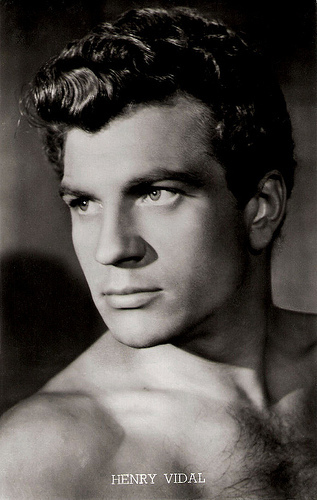
French postcard, no. 952.

French postcard by Editions P.I., La Garenne-Colombes, no. 22. Photo: Roger Carles.
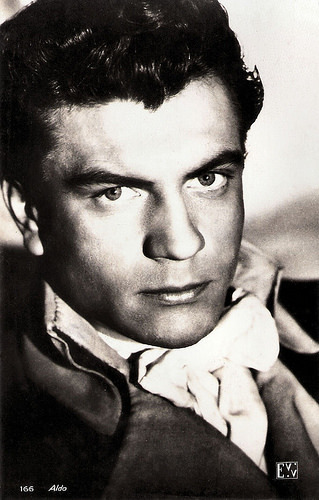
French postcard by Editions Votre Vedette (EVV), no. 166. Photo: Aldo Graziati.
Athletic Prowess
Henri Vidal was born in Clermont-Ferrand (some sources say in Royat), France, in 1919.
He started his acting acteer in small theatres, and was noted for his handsomeness and athletic prowess. When he took part in the beauty contest Apollon de l'année 1939 (Apollo of the Year 1939) he was discovered by Édith Piaf.
Vidal made his film debut in Montmartre-sur-Seine (Georges Lacombe, 1941) at the side of Piaf and Jean-Louis Barrault . The following years he appeared in numerous French films, including Les Maudits/The Damned (René Clément, 1947) with Marcel Dalio .
Nowadays he is best remembered for an Italian film, the Roman spectacle Fabiola (Alessandro Blasetti, 1949). At AllMovie , Hal Erickson writes: "After several years of wartime austerity, the Italian film industry returned to spectacle with Fabiola. (...) Originally released in 1949 at a length of 183 minutes, the French/Italian co-production was distributed to the U.S. two years later in a 96-minute version, retaining the action highlights but cutting the plot footage to incomprehensible ribbons."
French actress Michèle Morgan plays the title role in Fabiola, the daughter of a Roman aristocrat ( Michel Simon ) during the takeover by Emperor Constantine. Fabiola is irresistibly drawn to a Roman gladiator (Vidal), who is secretly working on behalf of the Christian Constantine. When the shooting of the film was finished the beautiful couple married.

French postcard by Editions P.I., Paris, no. 99. Photo: Pathé-Cinéma.

French postcard by Editions Chantal, Rueil, no. 12. Photo: Vog.

French postcard by Editions du Globe (EDUG), Paris, no. 84. Photo: Studio Harcourt.

French postcard by Editions O.P., Paris, no. 24. Photo: Studio Harcourt.

French postcard by Editions du Globe (EDUG), Paris, no. 761. Photo: Studio Harcourt.
Charmant Garçon
After his breakthrough Henri Vidal starred in several other films with Michèle Morgan , like La Belle que voilà/Here Is the Beauty (Jean-Paul Le Chanois, 1950), L'Étrange Madame X/The Strange Madame X (Jean Gremillon, 1951) and Napoléon (Sacha Guitry, 1955).
Other successful films in which he appeared were Orient Express (Carlo Ludovico Bragaglia, 1954), and Porte des Lilas (René Clair, 1957) opposite Pierre Brasseur .
Vidal starred opposite sex kitten Brigitte Bardot in the comedies Une parisienne/La parisienne (Michel Boisrond, 1957) and Voulez-vous danser avec moi?/Come Dance With Me! (Michel Boisrond, 1959). Other beauties with whom he was paired were Sophia Loren in Attila, Flagello di Dio/Attila (Pietro Francisci, 1954), Marina Vlady in the film noir Les Salauds Vont En Enfer/The Wicked Go to Hell (Robert Hossein, 1955), Mylène Démongeot in Sois Belle et Tais Toi/Be Beautiful but Shut Up (Marc Allégret, 1957), Zizi Jeanmaire in Charmants Garcons/Charming Boys (Henri Decoin, 1957) and Romy Schneider in Ein Engel auf Erden/Angel on Earth (Géza von Radványi, 1959).
Depressions drove Vidal into a drugs habit. He died of a heart attack in 1959, in Paris. Between 1941 and 1959 he had appeared in 36 films. His last film was La Bête à l'affût/Beast at Bay (Pierre Chenal, 1959) with Michel Piccoli and Françoise Arnoul .
Henri Vidal was married twice, first to Michèle Cordoue (1943-1946) (divorced) and the second time to Michèle Morgan (1950-1959).

French postcard.

French postcard by Editions P.I., Paris, no. 3 7 G. Presented by les Carbones Kores 'Carboplane'. Photo: Sam Lévin.

French postcard by Editions P.I., Paris, no. 1046. Photo: Sam Lévin.

French postcard by Editions du Globe (EDUG), no. 123. Photo: Teddy Piaz, Paris.

German postcard by Kolibri-Verlag. Photo: Prisma.
Sources: Hal Erickson (AllMovie), Sandra Brennan (AllMovie), Wikipedia and .

French postcard, no. 952.

French postcard by Editions P.I., La Garenne-Colombes, no. 22. Photo: Roger Carles.

French postcard by Editions Votre Vedette (EVV), no. 166. Photo: Aldo Graziati.
Athletic Prowess
Henri Vidal was born in Clermont-Ferrand (some sources say in Royat), France, in 1919.
He started his acting acteer in small theatres, and was noted for his handsomeness and athletic prowess. When he took part in the beauty contest Apollon de l'année 1939 (Apollo of the Year 1939) he was discovered by Édith Piaf.
Vidal made his film debut in Montmartre-sur-Seine (Georges Lacombe, 1941) at the side of Piaf and Jean-Louis Barrault . The following years he appeared in numerous French films, including Les Maudits/The Damned (René Clément, 1947) with Marcel Dalio .
Nowadays he is best remembered for an Italian film, the Roman spectacle Fabiola (Alessandro Blasetti, 1949). At AllMovie , Hal Erickson writes: "After several years of wartime austerity, the Italian film industry returned to spectacle with Fabiola. (...) Originally released in 1949 at a length of 183 minutes, the French/Italian co-production was distributed to the U.S. two years later in a 96-minute version, retaining the action highlights but cutting the plot footage to incomprehensible ribbons."
French actress Michèle Morgan plays the title role in Fabiola, the daughter of a Roman aristocrat ( Michel Simon ) during the takeover by Emperor Constantine. Fabiola is irresistibly drawn to a Roman gladiator (Vidal), who is secretly working on behalf of the Christian Constantine. When the shooting of the film was finished the beautiful couple married.

French postcard by Editions P.I., Paris, no. 99. Photo: Pathé-Cinéma.

French postcard by Editions Chantal, Rueil, no. 12. Photo: Vog.

French postcard by Editions du Globe (EDUG), Paris, no. 84. Photo: Studio Harcourt.

French postcard by Editions O.P., Paris, no. 24. Photo: Studio Harcourt.

French postcard by Editions du Globe (EDUG), Paris, no. 761. Photo: Studio Harcourt.
Charmant Garçon
After his breakthrough Henri Vidal starred in several other films with Michèle Morgan , like La Belle que voilà/Here Is the Beauty (Jean-Paul Le Chanois, 1950), L'Étrange Madame X/The Strange Madame X (Jean Gremillon, 1951) and Napoléon (Sacha Guitry, 1955).
Other successful films in which he appeared were Orient Express (Carlo Ludovico Bragaglia, 1954), and Porte des Lilas (René Clair, 1957) opposite Pierre Brasseur .
Vidal starred opposite sex kitten Brigitte Bardot in the comedies Une parisienne/La parisienne (Michel Boisrond, 1957) and Voulez-vous danser avec moi?/Come Dance With Me! (Michel Boisrond, 1959). Other beauties with whom he was paired were Sophia Loren in Attila, Flagello di Dio/Attila (Pietro Francisci, 1954), Marina Vlady in the film noir Les Salauds Vont En Enfer/The Wicked Go to Hell (Robert Hossein, 1955), Mylène Démongeot in Sois Belle et Tais Toi/Be Beautiful but Shut Up (Marc Allégret, 1957), Zizi Jeanmaire in Charmants Garcons/Charming Boys (Henri Decoin, 1957) and Romy Schneider in Ein Engel auf Erden/Angel on Earth (Géza von Radványi, 1959).
Depressions drove Vidal into a drugs habit. He died of a heart attack in 1959, in Paris. Between 1941 and 1959 he had appeared in 36 films. His last film was La Bête à l'affût/Beast at Bay (Pierre Chenal, 1959) with Michel Piccoli and Françoise Arnoul .
Henri Vidal was married twice, first to Michèle Cordoue (1943-1946) (divorced) and the second time to Michèle Morgan (1950-1959).

French postcard.

French postcard by Editions P.I., Paris, no. 3 7 G. Presented by les Carbones Kores 'Carboplane'. Photo: Sam Lévin.

French postcard by Editions P.I., Paris, no. 1046. Photo: Sam Lévin.

French postcard by Editions du Globe (EDUG), no. 123. Photo: Teddy Piaz, Paris.

German postcard by Kolibri-Verlag. Photo: Prisma.
Sources: Hal Erickson (AllMovie), Sandra Brennan (AllMovie), Wikipedia and .
Published on June 15, 2015 22:00
June 14, 2015
Ally Kolberg
Actress Ally Kolberg or Ally Kay had a brief career in the German silent cinema. During the late 1910s and early 1920s, she appeared in 16 German films and one Swedish production.

German postcard by Rotophot in the Film Sterne series, Berlin, no. 119/1. Photo: Becker & Maass.

German postcard by Rotophot in the Film Sterne series, Berlin, no. 119/5. Photo: Becker & Maass. Collection: Didier Hanson.
Bubi-comedies
Little is known about Ally Kolberg. During the First World War, she joined the German cinema and appeared in 17 films, often directed by female directors.
Her first film appearance was in the short comedy Einer für drei/One for Three (Hanna Henning, 1916) with Joseph Römer in his popular role as Bubi.
Next she appeared in another episode of the Bubi-series, Bubi ist eifersüchtig/Bubi is jealous (Hanna Henning, 1916).
This was followed up with roles in short films like Mutter/Mother (Hanna Henning, 1917) with Olga Engl, Arme kleine Helga/Poor little Helga (Hanna Henning, 1918) opposite Kurt Vespermann , Und hätte der Liebe nicht/And have not charity (Gertrud Scholz, 1918) with Johannes Riemann , and another Bubi-comedy, Weil ich dich liebe/Because I love you (Hanna Hening, 1918).

German postcard by Ross Verlag, Berlin, no. 253, 1919-1924. Photo: Ernst Schneider.
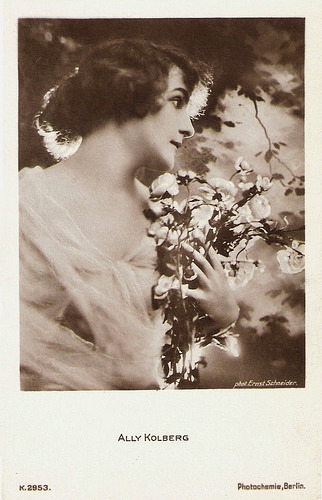
German postcard by Photochemie, Berlin, no. K. 2954. Photo: Ernst Schneider.
Fröken Ally?
In 1920, Ally Kolberg played in Die Augen der Maske/The eyes of the mask (Karl Gerhardt, 1920) opposite Lil Dagover , the Austrian-German production Das vierte Gebot/The Fourth Commandment (Richard Oswald, 1920), and Das Zeichen des Malayen/The Mark of the Malays (Carl Heinz Boese, 1920).
She was also credited as Ally Kay in films. Her later film roles were in Wem nie durch Liebe Leid geschah/Who never came through heartache (Heinz Schall, 1922) with Margit Barnay, and Die Spitzen der Gesellschaft/The leaders of society (Paul Heidemann, 1923).
In the Swedish production Fröken Fob/Miss Fob (Elis Ellis, 1923), she was credited as Ally Kay-Bing. The film, starring Renée Björling, was shot in Berlin studios, rented for this production
Was Ally Kolberg married now and did she retire from the film business to take care of her family? Possibly in Sweden?

German postcard by Ross Verlag, Berlin, no. 251. Photo: Ernst Schneider.

German postcard by Ross Verlag, Berlin, no. 255. Photo: Ernst Schneider.
Sources: Thomas Staedeli (Cyranos), Filmportal.de and .

German postcard by Rotophot in the Film Sterne series, Berlin, no. 119/1. Photo: Becker & Maass.

German postcard by Rotophot in the Film Sterne series, Berlin, no. 119/5. Photo: Becker & Maass. Collection: Didier Hanson.
Bubi-comedies
Little is known about Ally Kolberg. During the First World War, she joined the German cinema and appeared in 17 films, often directed by female directors.
Her first film appearance was in the short comedy Einer für drei/One for Three (Hanna Henning, 1916) with Joseph Römer in his popular role as Bubi.
Next she appeared in another episode of the Bubi-series, Bubi ist eifersüchtig/Bubi is jealous (Hanna Henning, 1916).
This was followed up with roles in short films like Mutter/Mother (Hanna Henning, 1917) with Olga Engl, Arme kleine Helga/Poor little Helga (Hanna Henning, 1918) opposite Kurt Vespermann , Und hätte der Liebe nicht/And have not charity (Gertrud Scholz, 1918) with Johannes Riemann , and another Bubi-comedy, Weil ich dich liebe/Because I love you (Hanna Hening, 1918).

German postcard by Ross Verlag, Berlin, no. 253, 1919-1924. Photo: Ernst Schneider.

German postcard by Photochemie, Berlin, no. K. 2954. Photo: Ernst Schneider.
Fröken Ally?
In 1920, Ally Kolberg played in Die Augen der Maske/The eyes of the mask (Karl Gerhardt, 1920) opposite Lil Dagover , the Austrian-German production Das vierte Gebot/The Fourth Commandment (Richard Oswald, 1920), and Das Zeichen des Malayen/The Mark of the Malays (Carl Heinz Boese, 1920).
She was also credited as Ally Kay in films. Her later film roles were in Wem nie durch Liebe Leid geschah/Who never came through heartache (Heinz Schall, 1922) with Margit Barnay, and Die Spitzen der Gesellschaft/The leaders of society (Paul Heidemann, 1923).
In the Swedish production Fröken Fob/Miss Fob (Elis Ellis, 1923), she was credited as Ally Kay-Bing. The film, starring Renée Björling, was shot in Berlin studios, rented for this production
Was Ally Kolberg married now and did she retire from the film business to take care of her family? Possibly in Sweden?

German postcard by Ross Verlag, Berlin, no. 251. Photo: Ernst Schneider.

German postcard by Ross Verlag, Berlin, no. 255. Photo: Ernst Schneider.
Sources: Thomas Staedeli (Cyranos), Filmportal.de and .
Published on June 14, 2015 22:00
June 13, 2015
Bibi Johns
Blond Swedish pop singer and actress Bibi Johns (1929) was very popular in Europe and the USA during the 1950s. She appeared in several European musical films. In Germany, where she lived from 1954 on, she would become a cult star of the Schlager music. Today she is also known as a painter.

German postcard by Universum-Film Aktiengesellschaft (Ufa), Berlin-Tempelhof, no. CK-91. Sent by mail in Germany in 1962. Photo: Arthur Grimm.

German postcard by Kunst und Bild, Berlin-Charlottenburg, no. CD 1.

German postcard by UFA, Berlin-Tempelhof, no. CK-92. Photo: Arthur Grimm.
Chance of a Lifetime
Bibi Johns was born Gun Birgit Johnsson in Arboga, Sweden, in 1929. There, her father Bertil Johnsson held a trucking business and her mother Anna was a housewife.
During her school years she already performed as a singer under the name of Gun Bertilson. She debuted 13 years old, in a song competition named Children’s day. After finishing school she attended at the request of her parents the fashion trade school in Stockholm.
In 1947, she secretly applied for the group Varat Gäng (Our Team) that she had met years earlier during a concert in her hometown. Varat Gäng was a very popular group in the 1940s consisting of music-talented children teens, that toured around Sweden playing Swing music. She sang and played clarinet and guitar, until the group disbanded in 1948.
During that time she had acquired the stage name Bibbi Johnson. After a few minor appearances, she completed her education at the fashion trade school. Then she joined the trio Yvonne Modin as a guitarist. Finally she joined Carl-Henrik Norin’s jazz band as a vocalist, and recorded her first 78 rpm record in 1949. She was also singing in Thore Swanerud’s jazz band, and the vocal groups The Serenaders and The Metronomers.
In 1951 she made her debut in Germany as a soloist in the entertainment orchestra of the SDR in Stuttgart. Later that year she sang during the Week of light music. An aunt invited her to New York and in 1951, she went to the US on an immigration visa. She started to sing in New York night clubs, and was soon working all over the east US. It was at this point that she started to call herself Bibi Johns on stage.
In 1952, RCA Victor Records offered her a record contract through Gordon Jenkins who supported stars such as Louis Armstrong, the Andrews Sisters, and Dick Haymes. In perfect English she made recordings of The Night Is Filled With Echoes and Someone To Kiss Your Tears Away. In 1953 she won the TV competition Chance of a Lifetime. The price was 1000 dollars, which she spent on a trip back to Sweden to visit her father for his 50th Birthday.

German postcard by Ufa, Berlin-Tempelhof, no. FK 1647. Photo: T. v. Mindszenty / Central Europa Film / Europa Film. Publicity still for Ball im Savoy/Ball at the Savoy (Paul Martin, 1955).

German postcard by F.J. Rüdel, Hamburg-Bergedorf, no. 1313. Photo: Central-Europa / Europa-Film / Frederico. Publicity still for Ball im Savoy/Ball at the Savoy (Paul Martin, 1955) with Bully Buhlan.

German postcard by Ufa, Berlin-Tempelhof, no. FK 3638. Photo: Arthur Grimm / CCC-Film / Constantin Film.

German postcard by WS-Druck, Wanne-Eickel, no. 106. Photo: Hans Deppe-Film / Czerwonski. Publicity still for Tausend Melodien/Thousand Melodies (Hans Deppe, 1956).

German postcard by Kolibri-Verlag, Minden/Westf., no. 399. Photo: Arthur Grimm / CCC / Constantin. Publicity still for Wehe, wenn sie losgelassen/Beware when she is released (Géza von Cziffra, 1958) with Peter Alexander .
Bella Bimba
In Sweden Bibi Johns met the German music producer Nils Nobach, who invited her to Germany for a test recording for the Electrola label before she returned to the US. She recorded in German Bella Bimba, Little Rock/Bye Bye Baby and her first big hit Sehnsucht (Longing) (1953). That song is now one of the evergreens of the Schlager (the German pop).
In the same year she made her first film appearance in the lead of the Swedish production Flicka med Melodie/A Girl With a Melody (Martin Söderhjelm, 1954). That year she also appeared in the German musical comedy An jedem Finger zehn/At Every Finger One (Erik Ode, 1954) with Germaine Damar .
She shuttled several times between Europe and the US. From 1954 she also had her permanent residence in Germany. In fact, she was the first in a row of Scandinavian Schlager singers that succeeded in Germany from the late 1950s to early 1970s. Her hits included Aber nachts in der Bar (But at Night in the Bar), Zwei Herzen im Mai (Two Hearts in May), and Die Gypsy Band (The Gypsy Band).
Occasionally Bibi visited Sweden to record songs, e.g. a Swedish version of Bella Bimba. However, she had her biggest audience in West Germany, where she was the star of the 1950s. She made several films including Ball im Savoy/Ball at Savoy (Paul Martin, 1955) starring Rudolf Prack , the comedy Ich und meine Schwiegersöhne/I and my sons-in-law (Georg Jacoby, 1956) with Grethe Weise, and Musikparade/Music Parade (Géza von Cziffra, 1956) with Peter Alexander .
She also sang with Erwin Lehn’s Südfunk dance orchestra in Stuttgart. In 1956 when the first German charts were published, Bibi Johns did not celebrate many great successes anymore. That year she participated at Grand Prix Eurovision 1956, the German pre-selection for the European Song Contest, where Lys Assia would be the winner.
In 1957 she moved to Polydor, for which she recorded duets with Peter Alexander , such as the hit Schon wieder mal (Again). She also co-starred with him in the musical comedies Liebe, Jazz und Übermut/Love, Jazz and High Spirits (Erik Ode, 1957) and Wehe, wenn sie losgelassen/Beware, when she's released(Géza von Cziffra, 1958).

German postcard by Filmbilder-Vertrieb Ernst Freihoff, Essen, no. 239. Retail price: 10 Pfg. Photo: Arthur Grimm.

German postcard by Filmbilder-Vertrieb Ernst Freihoff, Essen, no. 153. Photo: Arthur Grimm.

German postcard by Kolibri-Verlag G.m.bH., Minden (Westf.), no. D 12. Photo: Real / Europa Film. Publicity still for Ich und meine Schwiegersöhne/I and my sons-in-law (Georg Jacoby, 1956).

German postcard by WS-Druck, Wanne-Eickel. Photo: Hans Deppe-Film / Czerwonski.
Cult Star of the Schlager
In the early 1960s, the sales of Bibi Johns’ records subsided somewhat. She returned to Sweden to produce her own stage shows, for tours in the folk parks. For the first time she now had hit singles in her native country, e.g. Leka med elden, Bröllopet and Bibi's Bossa Nova.
In Germany she was frequently seen in various television shows. She had her own special Kennen Sie Miss Johns/Have You Met Miss Johns? She was directed by her then-husband Michael Pfleghar in the popular TV-film Zu jung um blond zu sein/Too Young To Be Blond (Michael Pfleghar, 1961) starring the Kessler twins . Another popular TV-film was Paris ist eine Reise wert/Paris is Worth a Trip (Paul Martin, 1966) with Fernandel and Gus Backus .
In 1966 Bibi Johns also competed at the Deutsche Schlager-Festival in Baden-Baden, but she didn’t reach the final. In the following years she appeared often on TV. In 1970 she worked in London as a singer and hostess at the Rolf Harris Show, a coproduction of the German ZDF and the British BBC, and in 1971 she went on tour with pop singer Tom Jones . One of her last TV appearances was in Der Mann am Klavier/The Man at the Piano (Ekkehard Böhmer, 1985) with Gilbert Bécaud . Till in the 1990s she starred in numerous nostalgia shows, and became one of the cult stars of the German Schlager.
In 1975 she decided to try painting, and started to study fine arts in Munich. Since then, she has made a career as an artist, exhibiting her paintings around Germany. Bibi Johns was married twice. In the early 1950s she was briefly married to an American. Her second husband was the film director Michael Pfleghar (1960-1962). Then she lived for several years with the pianist Peter Jacques, with whom she worked in the musical Das Schlüssel-Karussell (The Key Carousel). Between 1974 and ca. 1990 the composer Rob Pronk was her partner and since 1997 she has lived with the 40 years younger classic pianist Alex Racic. They live in Pullach near München (Munich).

German autograph card. Photo: Dörte Gröning.
Bibi Johns sings Das mach ich mit musik in Musikparade 1956 (Géza von Cziffra, 1956). Source: Della Street (YouTube).
Bibi Johns sing Kannst du schon den Calypso (1957). Source: Frit51261 (YouTube).
Bibi Johns and Peter Alexander sing Vergiß mich nicht so schnell in Liebe, Jazz und Übermut/Love, Jazz and High Spirits (Erik Ode, 1957). Source: Aschenrind (YouTube).
Source: Bibi Johns Website, Stephanie D’heil (Steffi-line - German), Greg Adams (AllMusic), Wikipedia (German), and .

German postcard by Universum-Film Aktiengesellschaft (Ufa), Berlin-Tempelhof, no. CK-91. Sent by mail in Germany in 1962. Photo: Arthur Grimm.

German postcard by Kunst und Bild, Berlin-Charlottenburg, no. CD 1.

German postcard by UFA, Berlin-Tempelhof, no. CK-92. Photo: Arthur Grimm.
Chance of a Lifetime
Bibi Johns was born Gun Birgit Johnsson in Arboga, Sweden, in 1929. There, her father Bertil Johnsson held a trucking business and her mother Anna was a housewife.
During her school years she already performed as a singer under the name of Gun Bertilson. She debuted 13 years old, in a song competition named Children’s day. After finishing school she attended at the request of her parents the fashion trade school in Stockholm.
In 1947, she secretly applied for the group Varat Gäng (Our Team) that she had met years earlier during a concert in her hometown. Varat Gäng was a very popular group in the 1940s consisting of music-talented children teens, that toured around Sweden playing Swing music. She sang and played clarinet and guitar, until the group disbanded in 1948.
During that time she had acquired the stage name Bibbi Johnson. After a few minor appearances, she completed her education at the fashion trade school. Then she joined the trio Yvonne Modin as a guitarist. Finally she joined Carl-Henrik Norin’s jazz band as a vocalist, and recorded her first 78 rpm record in 1949. She was also singing in Thore Swanerud’s jazz band, and the vocal groups The Serenaders and The Metronomers.
In 1951 she made her debut in Germany as a soloist in the entertainment orchestra of the SDR in Stuttgart. Later that year she sang during the Week of light music. An aunt invited her to New York and in 1951, she went to the US on an immigration visa. She started to sing in New York night clubs, and was soon working all over the east US. It was at this point that she started to call herself Bibi Johns on stage.
In 1952, RCA Victor Records offered her a record contract through Gordon Jenkins who supported stars such as Louis Armstrong, the Andrews Sisters, and Dick Haymes. In perfect English she made recordings of The Night Is Filled With Echoes and Someone To Kiss Your Tears Away. In 1953 she won the TV competition Chance of a Lifetime. The price was 1000 dollars, which she spent on a trip back to Sweden to visit her father for his 50th Birthday.

German postcard by Ufa, Berlin-Tempelhof, no. FK 1647. Photo: T. v. Mindszenty / Central Europa Film / Europa Film. Publicity still for Ball im Savoy/Ball at the Savoy (Paul Martin, 1955).

German postcard by F.J. Rüdel, Hamburg-Bergedorf, no. 1313. Photo: Central-Europa / Europa-Film / Frederico. Publicity still for Ball im Savoy/Ball at the Savoy (Paul Martin, 1955) with Bully Buhlan.

German postcard by Ufa, Berlin-Tempelhof, no. FK 3638. Photo: Arthur Grimm / CCC-Film / Constantin Film.

German postcard by WS-Druck, Wanne-Eickel, no. 106. Photo: Hans Deppe-Film / Czerwonski. Publicity still for Tausend Melodien/Thousand Melodies (Hans Deppe, 1956).

German postcard by Kolibri-Verlag, Minden/Westf., no. 399. Photo: Arthur Grimm / CCC / Constantin. Publicity still for Wehe, wenn sie losgelassen/Beware when she is released (Géza von Cziffra, 1958) with Peter Alexander .
Bella Bimba
In Sweden Bibi Johns met the German music producer Nils Nobach, who invited her to Germany for a test recording for the Electrola label before she returned to the US. She recorded in German Bella Bimba, Little Rock/Bye Bye Baby and her first big hit Sehnsucht (Longing) (1953). That song is now one of the evergreens of the Schlager (the German pop).
In the same year she made her first film appearance in the lead of the Swedish production Flicka med Melodie/A Girl With a Melody (Martin Söderhjelm, 1954). That year she also appeared in the German musical comedy An jedem Finger zehn/At Every Finger One (Erik Ode, 1954) with Germaine Damar .
She shuttled several times between Europe and the US. From 1954 she also had her permanent residence in Germany. In fact, she was the first in a row of Scandinavian Schlager singers that succeeded in Germany from the late 1950s to early 1970s. Her hits included Aber nachts in der Bar (But at Night in the Bar), Zwei Herzen im Mai (Two Hearts in May), and Die Gypsy Band (The Gypsy Band).
Occasionally Bibi visited Sweden to record songs, e.g. a Swedish version of Bella Bimba. However, she had her biggest audience in West Germany, where she was the star of the 1950s. She made several films including Ball im Savoy/Ball at Savoy (Paul Martin, 1955) starring Rudolf Prack , the comedy Ich und meine Schwiegersöhne/I and my sons-in-law (Georg Jacoby, 1956) with Grethe Weise, and Musikparade/Music Parade (Géza von Cziffra, 1956) with Peter Alexander .
She also sang with Erwin Lehn’s Südfunk dance orchestra in Stuttgart. In 1956 when the first German charts were published, Bibi Johns did not celebrate many great successes anymore. That year she participated at Grand Prix Eurovision 1956, the German pre-selection for the European Song Contest, where Lys Assia would be the winner.
In 1957 she moved to Polydor, for which she recorded duets with Peter Alexander , such as the hit Schon wieder mal (Again). She also co-starred with him in the musical comedies Liebe, Jazz und Übermut/Love, Jazz and High Spirits (Erik Ode, 1957) and Wehe, wenn sie losgelassen/Beware, when she's released(Géza von Cziffra, 1958).

German postcard by Filmbilder-Vertrieb Ernst Freihoff, Essen, no. 239. Retail price: 10 Pfg. Photo: Arthur Grimm.

German postcard by Filmbilder-Vertrieb Ernst Freihoff, Essen, no. 153. Photo: Arthur Grimm.

German postcard by Kolibri-Verlag G.m.bH., Minden (Westf.), no. D 12. Photo: Real / Europa Film. Publicity still for Ich und meine Schwiegersöhne/I and my sons-in-law (Georg Jacoby, 1956).

German postcard by WS-Druck, Wanne-Eickel. Photo: Hans Deppe-Film / Czerwonski.
Cult Star of the Schlager
In the early 1960s, the sales of Bibi Johns’ records subsided somewhat. She returned to Sweden to produce her own stage shows, for tours in the folk parks. For the first time she now had hit singles in her native country, e.g. Leka med elden, Bröllopet and Bibi's Bossa Nova.
In Germany she was frequently seen in various television shows. She had her own special Kennen Sie Miss Johns/Have You Met Miss Johns? She was directed by her then-husband Michael Pfleghar in the popular TV-film Zu jung um blond zu sein/Too Young To Be Blond (Michael Pfleghar, 1961) starring the Kessler twins . Another popular TV-film was Paris ist eine Reise wert/Paris is Worth a Trip (Paul Martin, 1966) with Fernandel and Gus Backus .
In 1966 Bibi Johns also competed at the Deutsche Schlager-Festival in Baden-Baden, but she didn’t reach the final. In the following years she appeared often on TV. In 1970 she worked in London as a singer and hostess at the Rolf Harris Show, a coproduction of the German ZDF and the British BBC, and in 1971 she went on tour with pop singer Tom Jones . One of her last TV appearances was in Der Mann am Klavier/The Man at the Piano (Ekkehard Böhmer, 1985) with Gilbert Bécaud . Till in the 1990s she starred in numerous nostalgia shows, and became one of the cult stars of the German Schlager.
In 1975 she decided to try painting, and started to study fine arts in Munich. Since then, she has made a career as an artist, exhibiting her paintings around Germany. Bibi Johns was married twice. In the early 1950s she was briefly married to an American. Her second husband was the film director Michael Pfleghar (1960-1962). Then she lived for several years with the pianist Peter Jacques, with whom she worked in the musical Das Schlüssel-Karussell (The Key Carousel). Between 1974 and ca. 1990 the composer Rob Pronk was her partner and since 1997 she has lived with the 40 years younger classic pianist Alex Racic. They live in Pullach near München (Munich).

German autograph card. Photo: Dörte Gröning.
Bibi Johns sings Das mach ich mit musik in Musikparade 1956 (Géza von Cziffra, 1956). Source: Della Street (YouTube).
Bibi Johns sing Kannst du schon den Calypso (1957). Source: Frit51261 (YouTube).
Bibi Johns and Peter Alexander sing Vergiß mich nicht so schnell in Liebe, Jazz und Übermut/Love, Jazz and High Spirits (Erik Ode, 1957). Source: Aschenrind (YouTube).
Source: Bibi Johns Website, Stephanie D’heil (Steffi-line - German), Greg Adams (AllMusic), Wikipedia (German), and .
Published on June 13, 2015 22:00
Paul van Yperen's Blog
- Paul van Yperen's profile
- 13 followers
Paul van Yperen isn't a Goodreads Author
(yet),
but they
do have a blog,
so here are some recent posts imported from
their feed.



